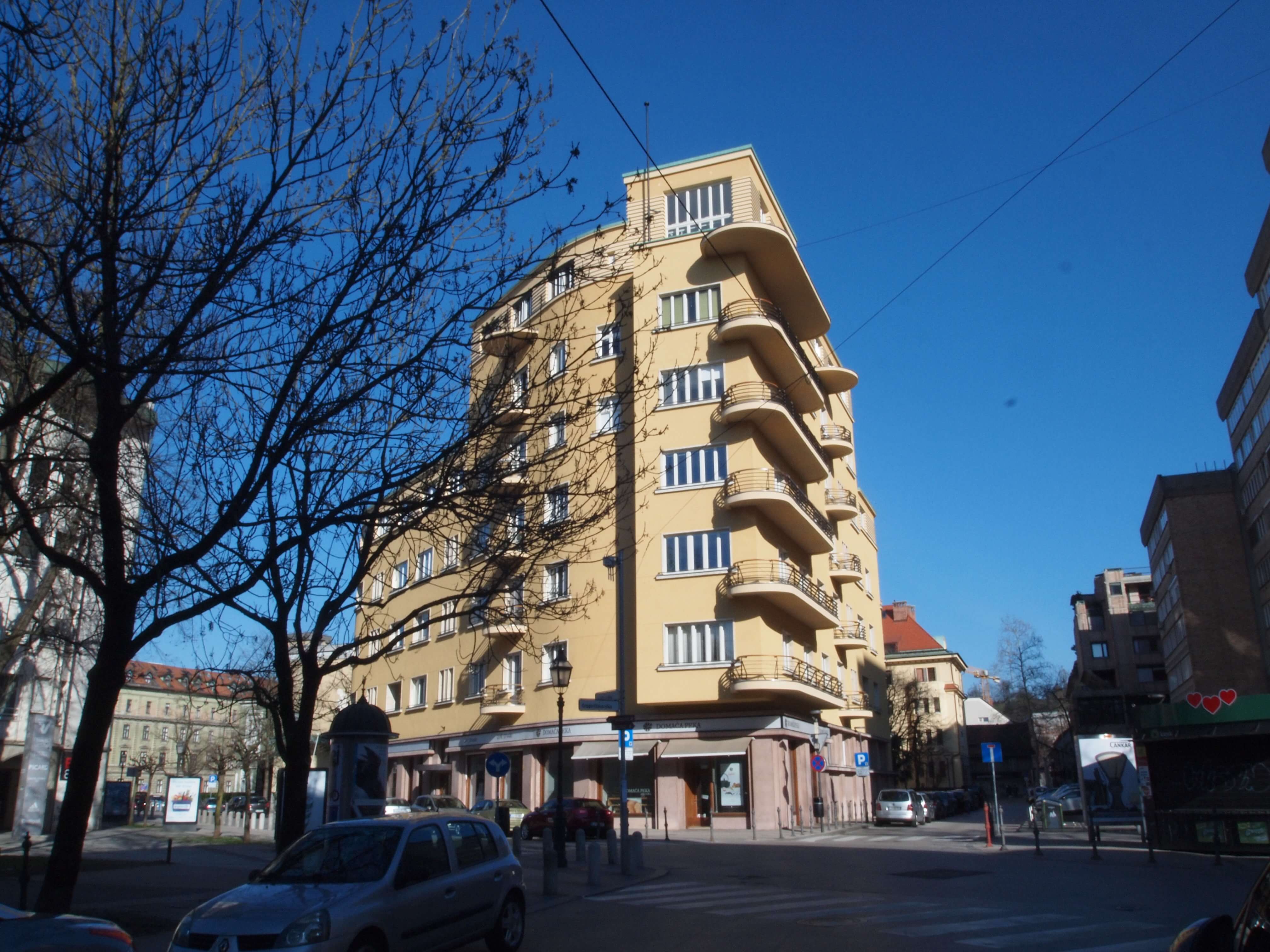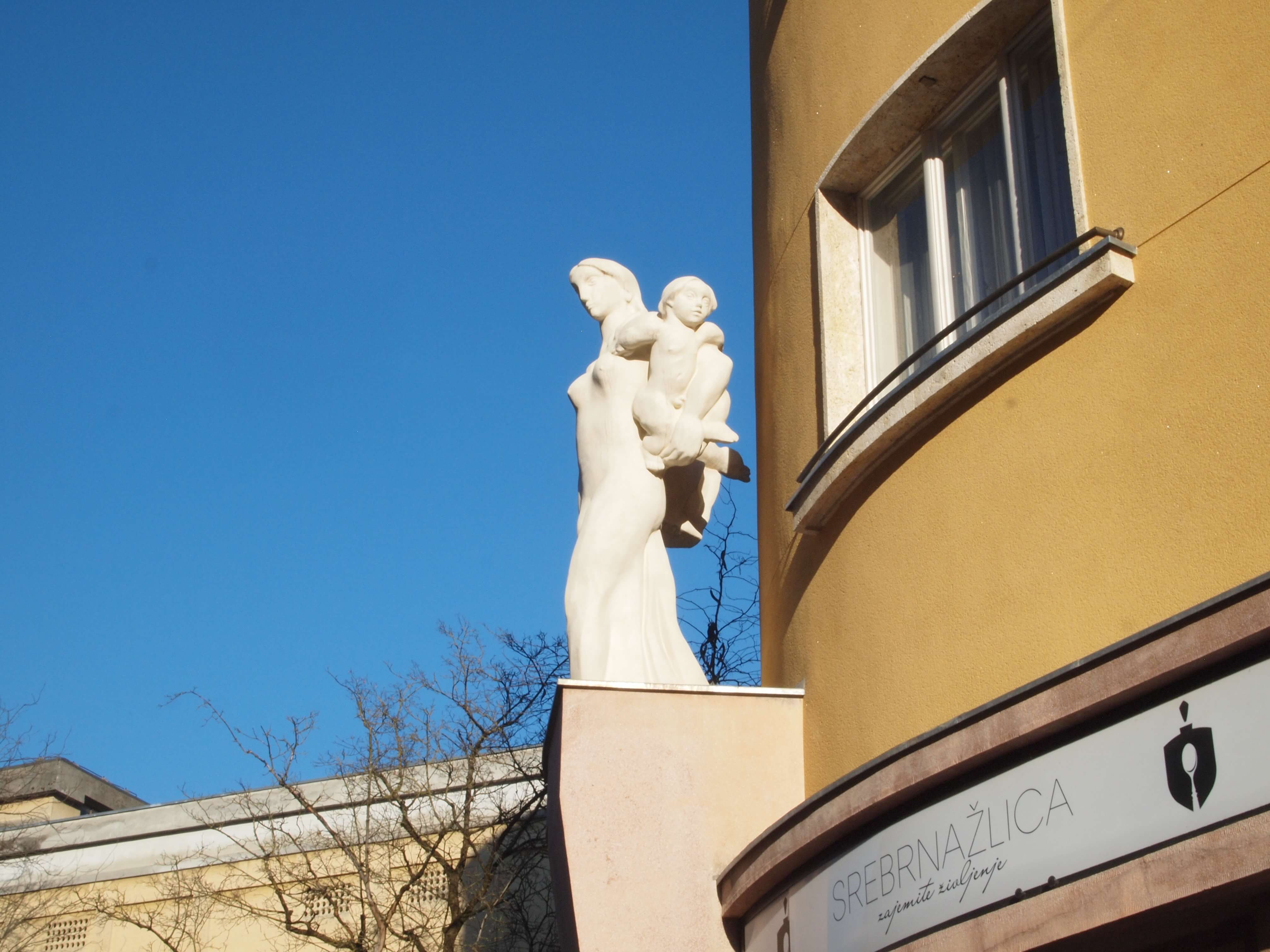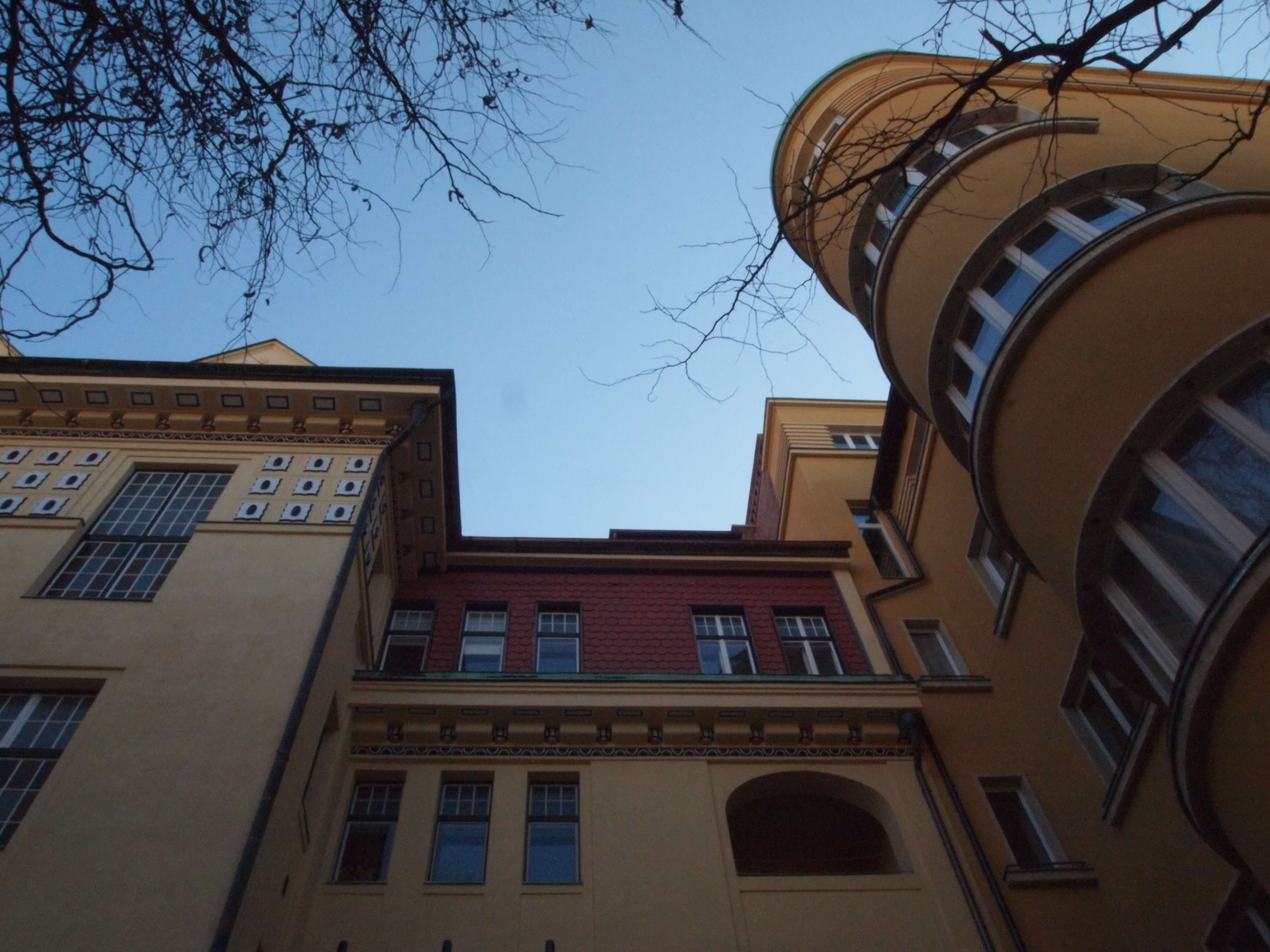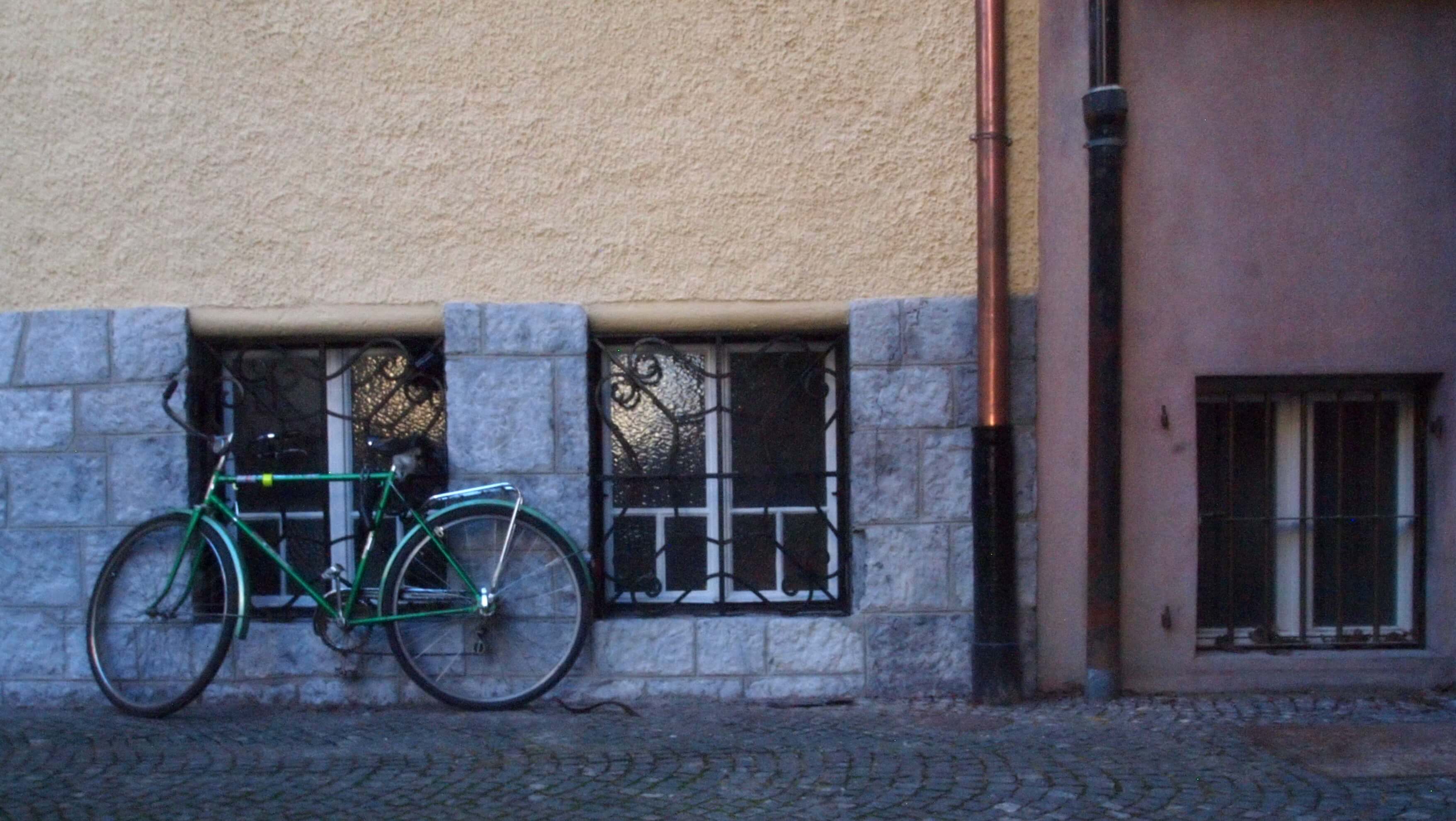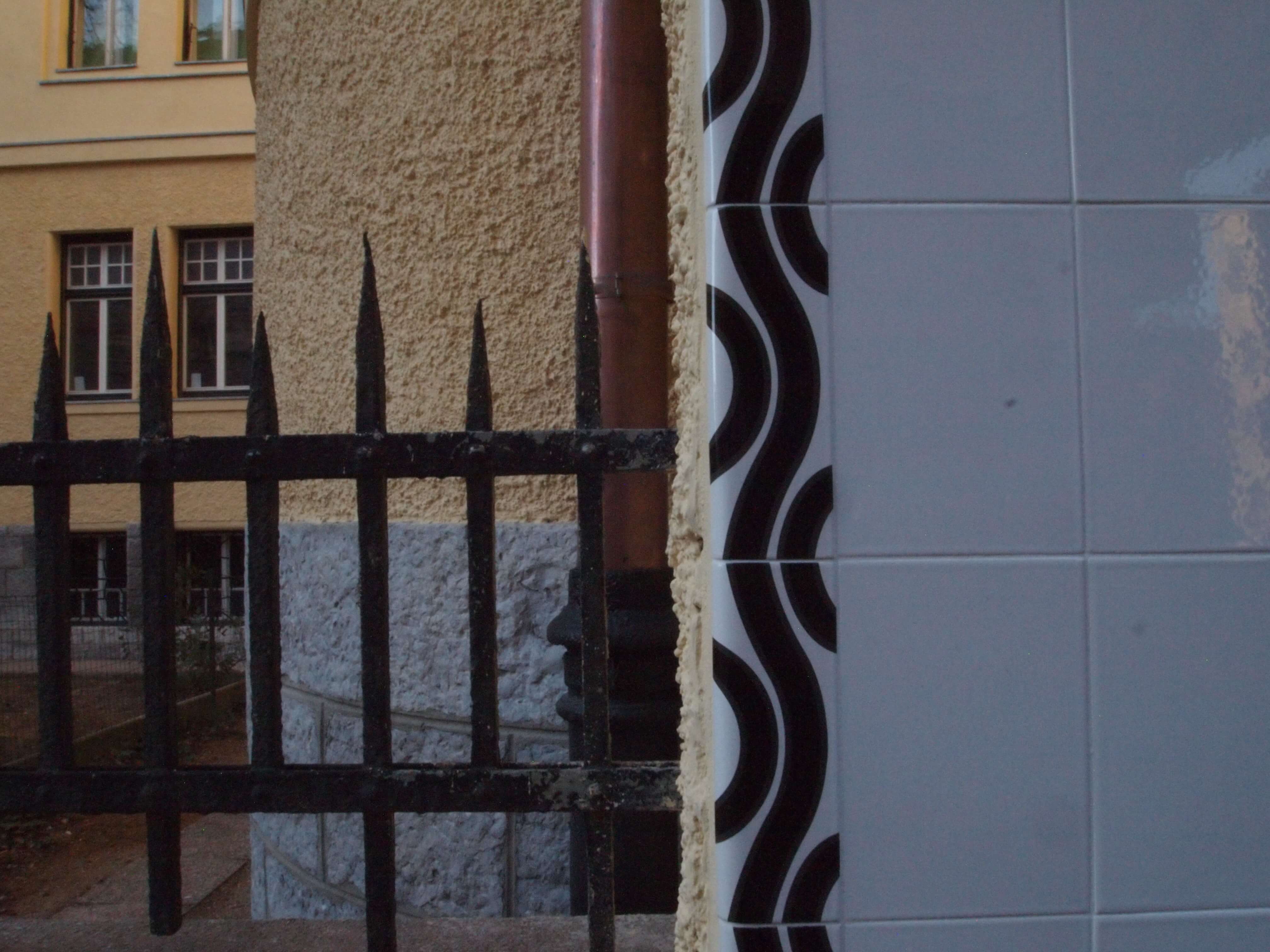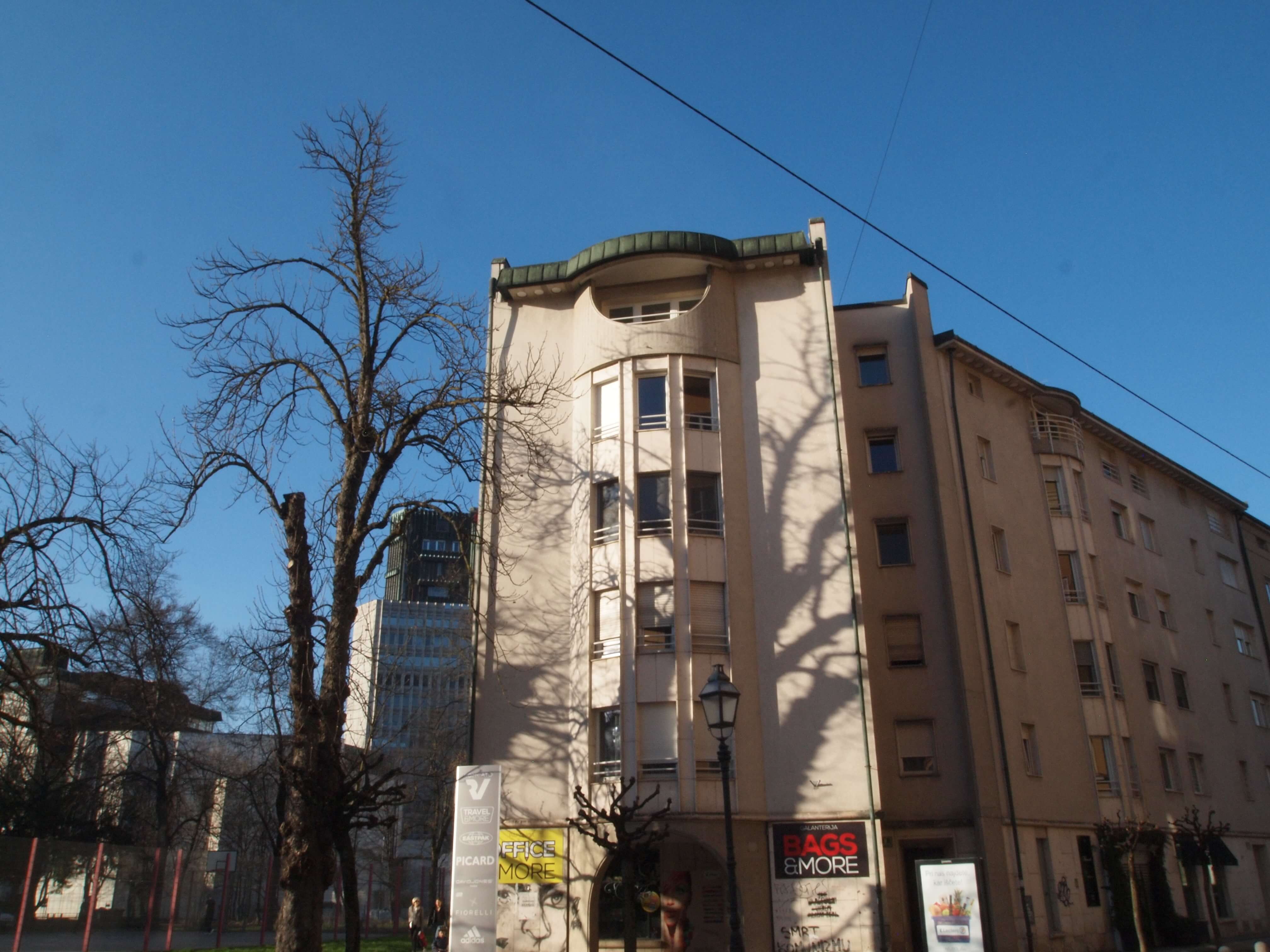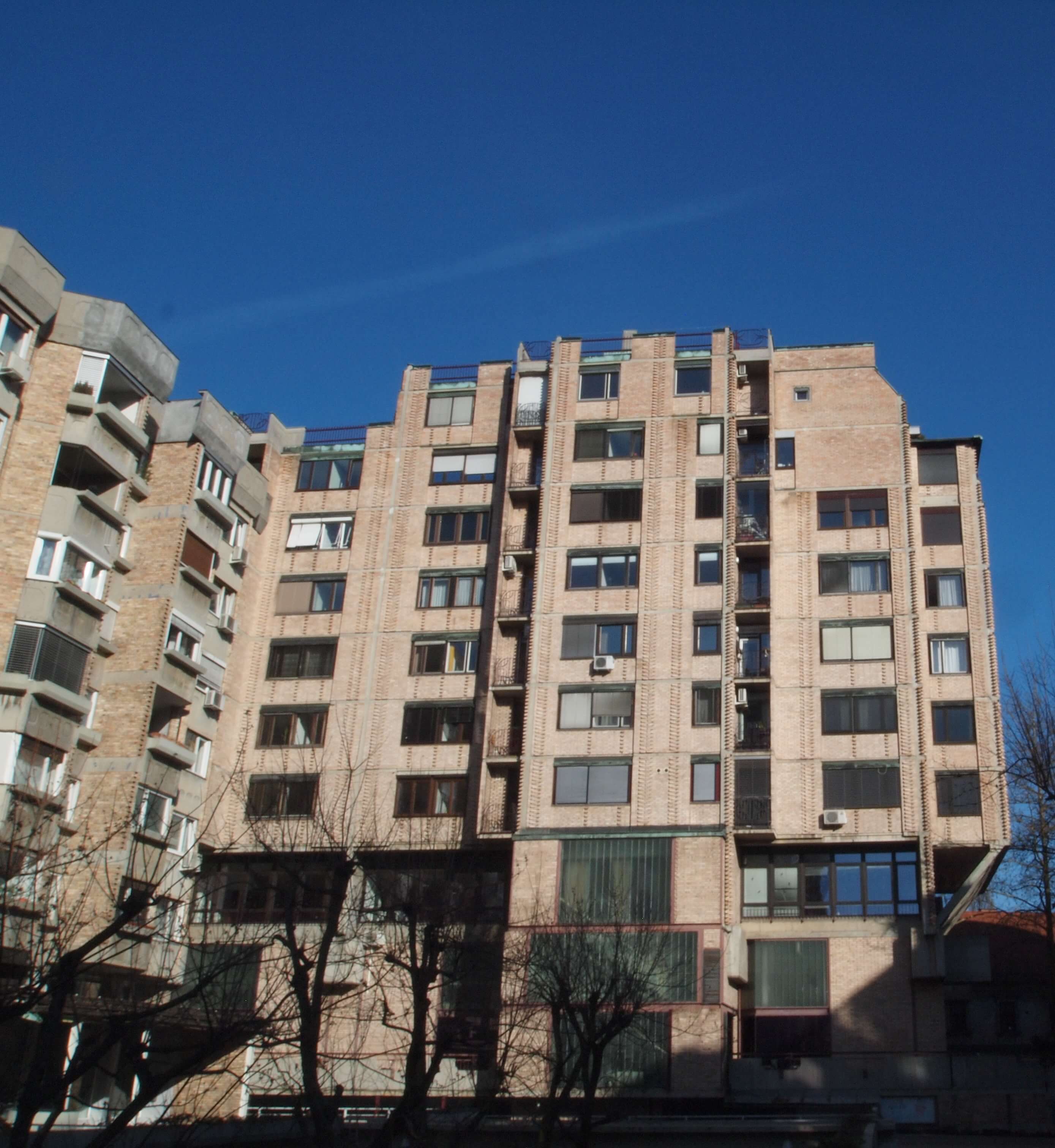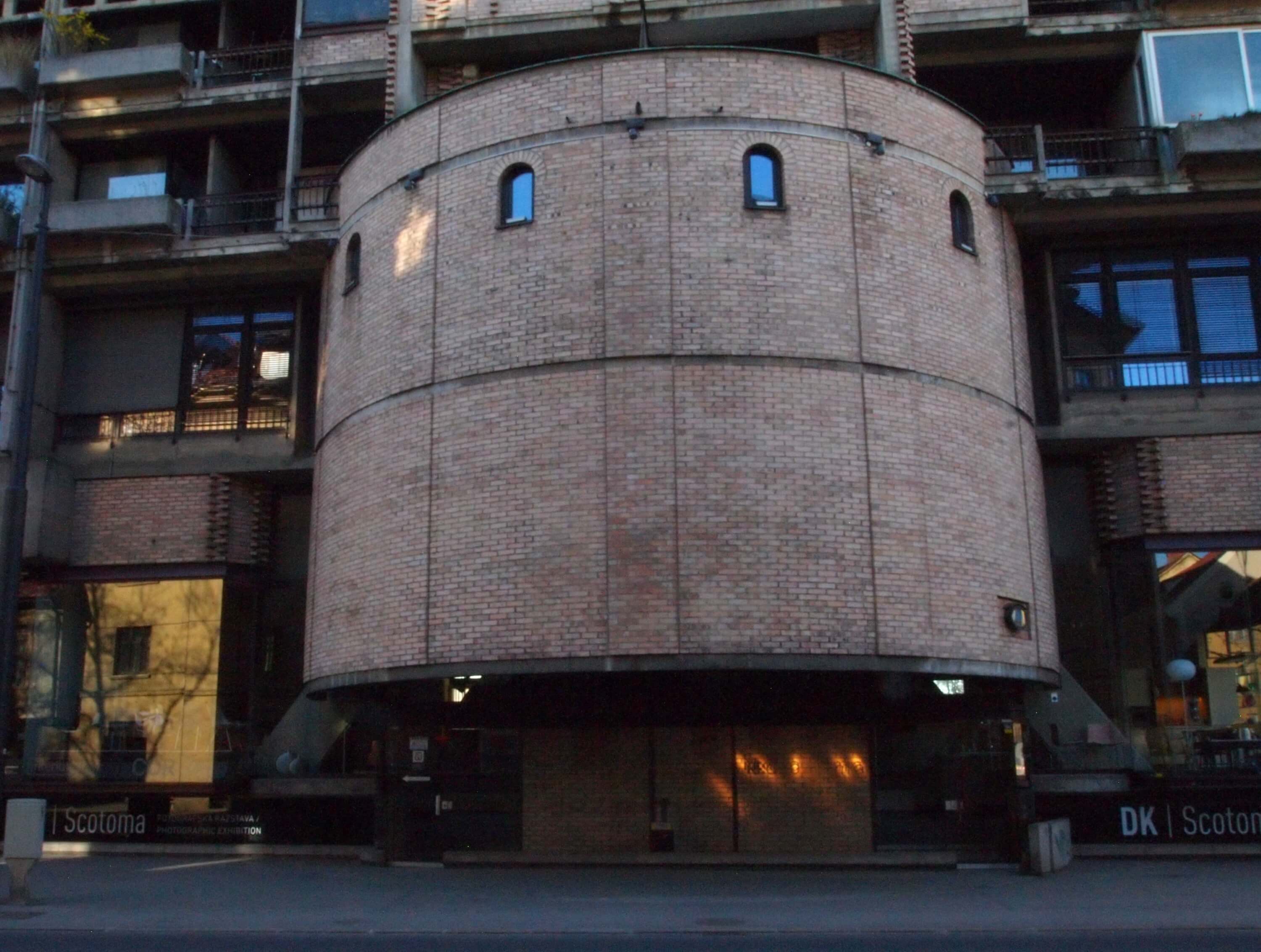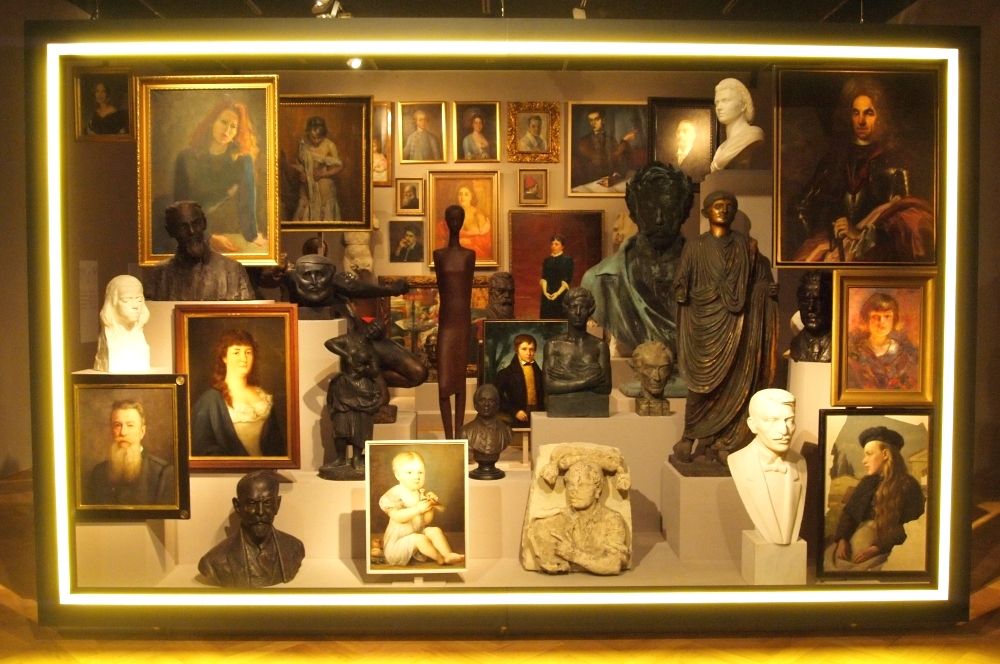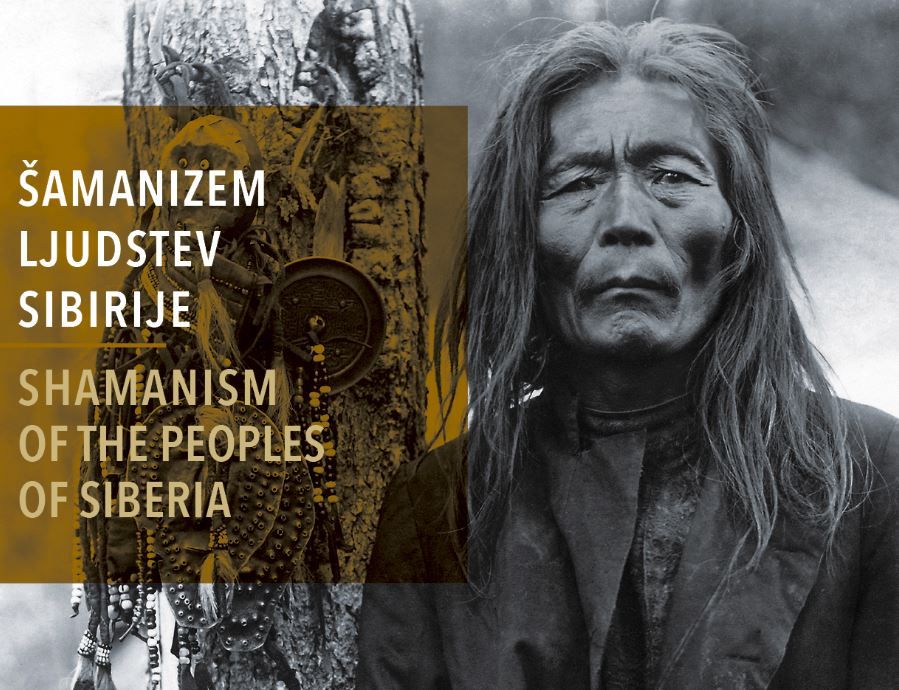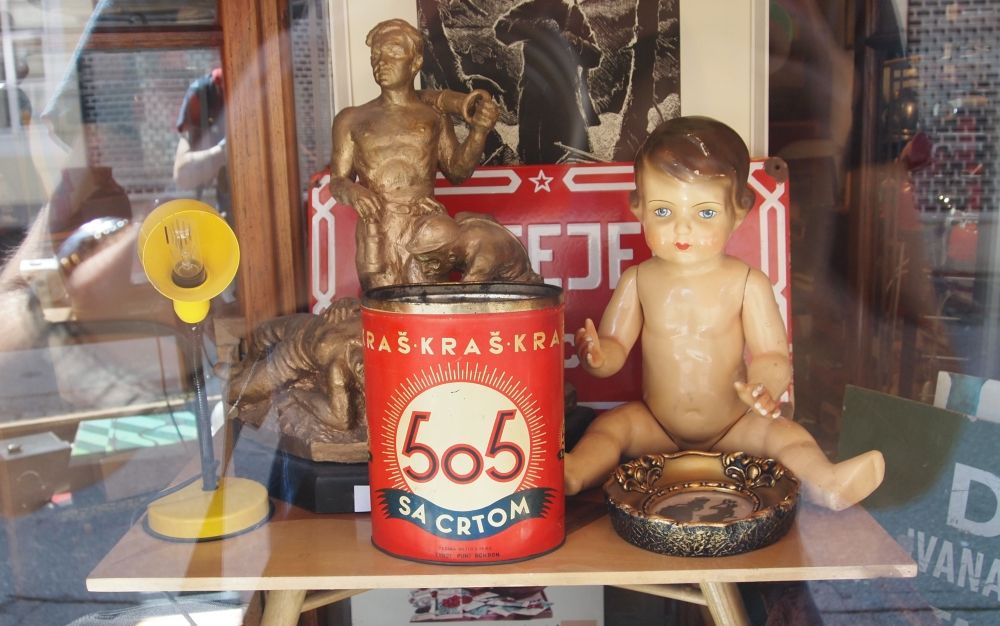News
A little while ago I wrote about a wonderful guidebook to the capital, Let’s See Ljubljana… Beyond its utility and charm, it’s a book that means a lot to me personally, because when I first arrived in Slovenia and was hit by culture shock and disorientation, after almost two decades in the 24/7/365 neon glare of Asia, it gave me a way into the quiet town of Ljubljana through reliable landmarks that had stood the test of time and would serve as anchors for my new life
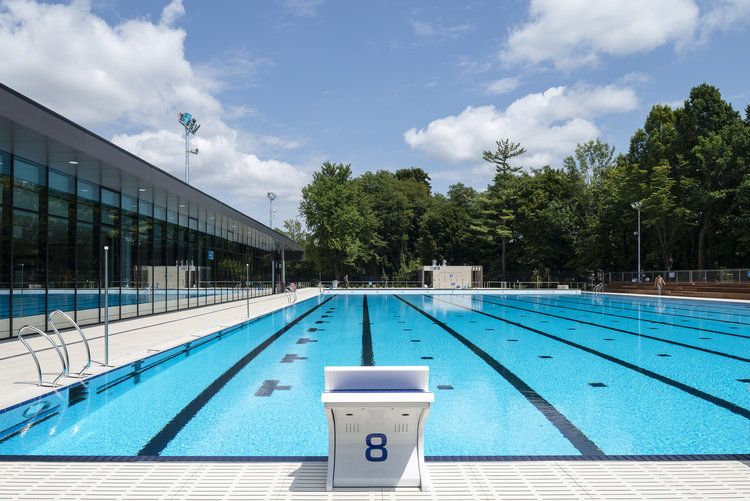
Swimming pool, Kolezija, Ljubljana. Designed by Ravnikar- Potokar. Photo: Virginia Vrecl
I adopted the pen name JL Flanner because it was slightly more subtle than LJ Flâneur, but the intent and belief remained. If I gave myself up to the city then I’d be rewarded somehow, even if just with a better sense of place and a clearer understanding of my surroundings. So when I got the chance to meet one of the authors, Robert Potokar – the other being his partner in life and work, Špela Kuhar – I jumped at it, both to express my gratitude and to see what else I could learn. It was a meeting that exceeded all expectations.

Buildings in Nature Reserve Škocjanski Zatok, Koper. Designed by Ravnikar- Potokar. Photo: Virginia Vrecl
Robert and Špela work Ravnikar - Potokar, and fans of architecture will recognise that second name, although note that this Ravnikar isn’t directly related to Edvard, the student of Plečnik who also left a considerable mark on the Slovenian capital. Edvard Ravnikar’s most visible work in Ljubljana is the complex in Republika trg, but his work there stretches out beyond this monumental landmark, and is easily spotted if you’re familiar with some of his recurring motifs, like the brickwork patterns and copper roofs. It’s in one of these other buildings, just a short walk away, that Ravnikar - Potokar has its offices, and where I met Robert to thank him for his work. We had a long, undirected conversation, without interview questions and with a walk through the neighbourhood, and what follows is some of what I learned.
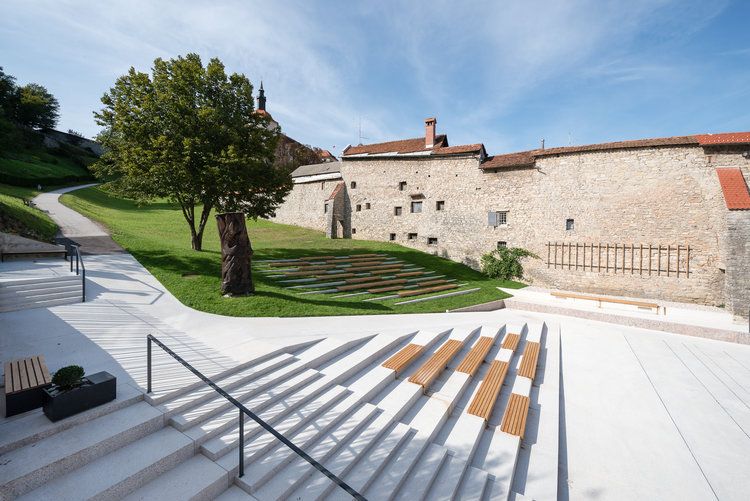
A Square and a Playground Under the Castle in Škofja Loka. Designed by Ravnikar- Potokar. Photo: Virginia Vrecl
On his books
I was born in Kranj, but I spent my childhood in Škofja Loka, which is my first love. I’ve also written a guidebook for the Gorenjska region, along with my wife, Špela Kuhar, going through all the important buildings. Traditional architecture, local architecture, churches, everything. An overview of the whole region. It was a lot of work, and people ask we if I’ll make another one, but, well, it’s a lot of work. You start a book and you think this will be a one year project. But then you go deeper, and it’s fractal, it just keeps growing, and if you don’t have a deadline it’s never-ending.
In between we succeeded in making make another guide to Ljubljana. But in general now we focus on the architectural magazine, Piranesi, and that’s OK. In our work, in architecture or life, we just make a few things, but I hope they are important.
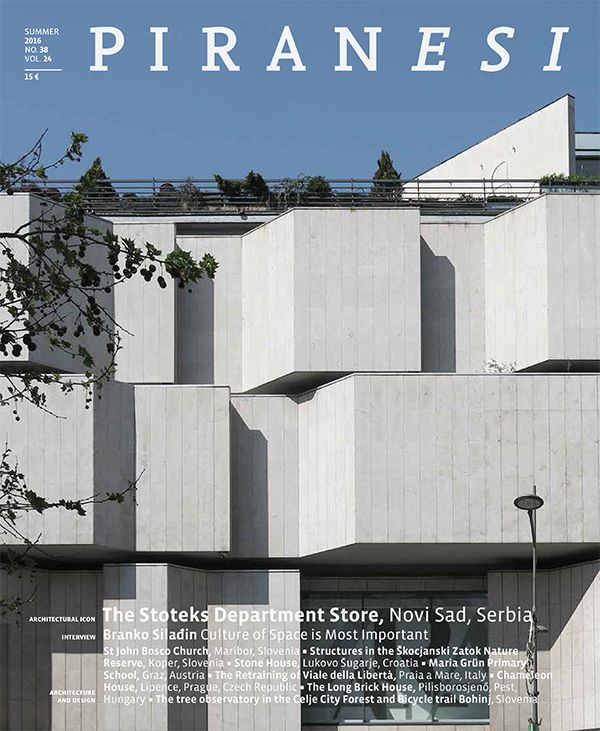
On Ljubljana
I like Ljubljana because it’s not too big, not too small, and it’s still the capital. If you know the advertisement which was on TV for the car Clio – it’s got everything a big one has.
When it’s possible and there’s enough time I walk to work from my home in Trnovo, going different ways and seeing what’s new, or new to me. Seeing people, seeing architecture. When I take people or tourists around the city we don’t only look at buildings, but also things that are nice or not so well known, and in this way they can remember the architecture better itself, and the way the city functions as an evolving whole, with different layers of history and use still present, even today.
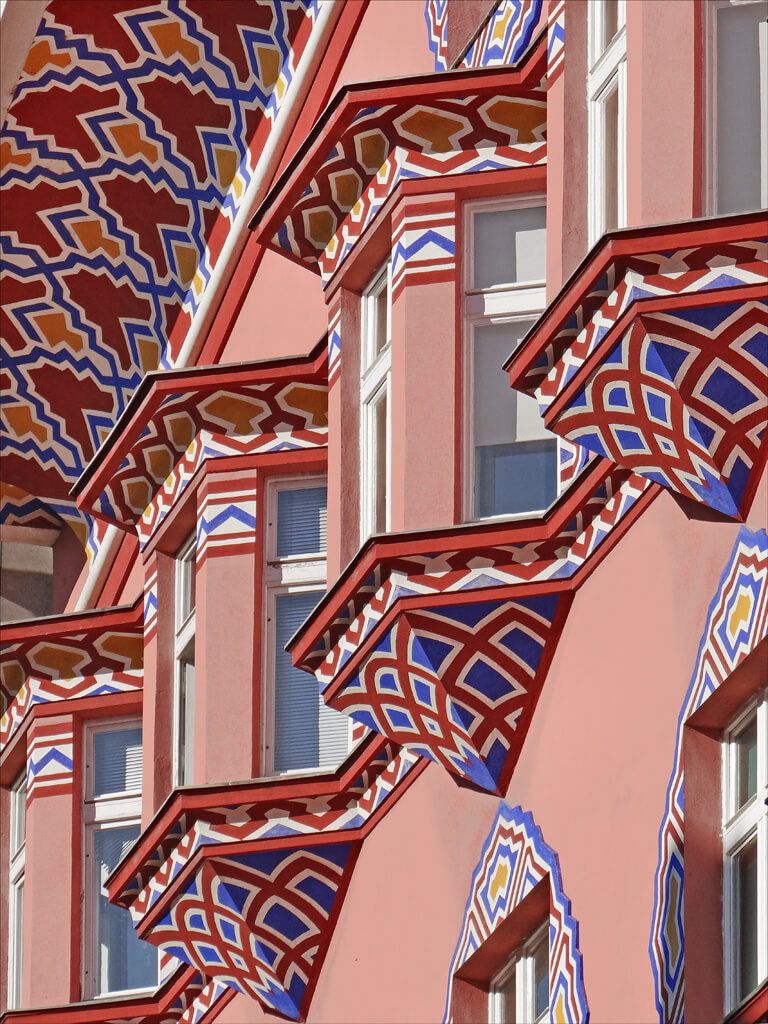
The Cooperative Business Bank Building on Miklošičeva. Flickr - Jean-Pierre Dalbéra CC-by-2.0
How things have changed
Do you know the Cooperative Business Bank Building on Miklošičeva? After the Second World War, during socialist times, people were like “come on, this is so ugly, all these decorative elements.” In the 50s, 60s, 70s, maybe even until the 90s, it was seen as nothing special. It was in bad repair and that kind of decoration was out of fashion. But after tourism developed it became one of the most notable and characteristic buildings. A building which is kept in our memory.
So it’s interesting how things change over time. When it was built it was important, and then for decades it was not, architects just didn’t like it.
It’s the same with Plečnik. It wasn’t until the big exhibition of his work, in 1986 in Paris, that he somehow came back to Ljubljana. It was a time of postmodernism, a boom in decoration, and that’s when he got rediscovered. You know, in the 60s and 70s people weren’t really taught about him at the Faculty of Architecture. I was there in the 80s, and we went to Paris to see that show and it was actually a surprise to see what he’d done.
Mali Nebotičnik
On his favourite building
My favourite in the city of Ljubljana is one just near here, on this street, Mali Nebotičnik (“Little Skyscraper” - see map here). It’s an example of modernist architecture, and in my opinion one of the best, from the 1930s. And not just here, but really in the world. In a way it’s so simple, but it fits the location perfectly and it’s got all typical modernist elements: curved lines as well balconies, railings, details and a sculpture by sculptor Tone Kralj. Modernism was known by adding sculptures on the façades. There are some other buildings like this in Ljubljana, such as at Argentinski Park, but this is the nicest. It’s not so well known, but it’s got really a lot of remarkable features, especially how it fits into the place, although the inside isn’t so special.
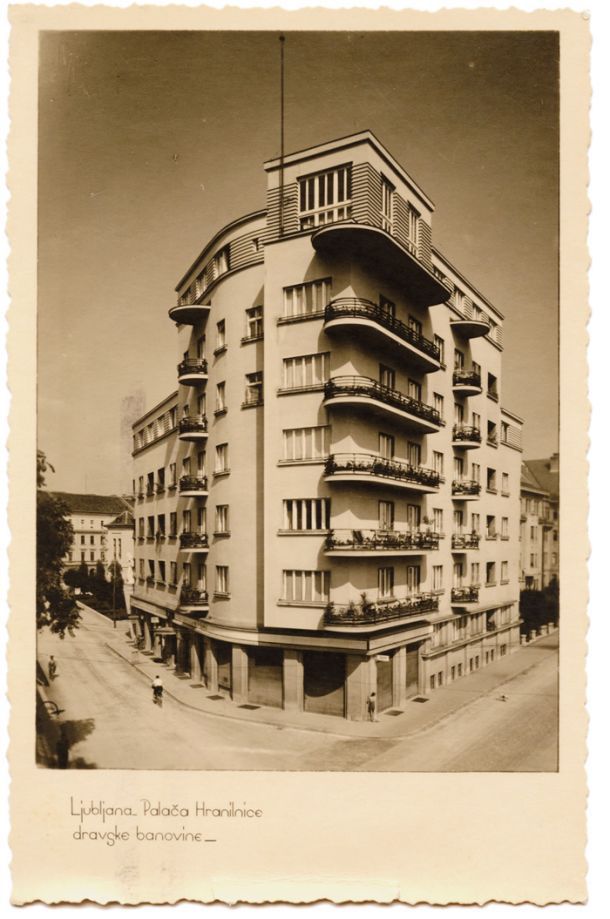
Postcard of Mali Nebotičnik (1930s? 40s?). Wikimedia, public domain
Because of its location, right in the centre, the people who bought apartments were rich, or artists. It was renovated just last year, and they did it very well, more or less the same colour as before, perhaps a little more vivid.
It wasn’t so out of fashion as Plečnik, because it isn’t so decorative, and in many ways not so different to socialist architecture, so aesthetically, ideologically, it didn’t have so many problems.
The lighting system for the store names is original, and really well done, with this style being common all over Europe in the 1930s, and even in Argentina, Buenos Aires. Curved balconies are very common, and the top floor is higher because there were studios inside.
If you look at the building next door, built by a German architect, I think, in around 1910, you can see how the architect of the Little Skyscraper (Herman Hus) understood the location, in urbanistic terms, and was able to integrate his work into the space.
If you look at this building here [see below], I think it was done in the 80s, and the architect tried to use some of the same elements, but it’s not as nice (although nothing is).
On Edvard Ravnikar
My late partner in this firm (Ravnikar – Potokar) was called Vojteh Ravnikar, but no relation to Edvard. In fact, the building we’re in now, part of the Ferantov vrt complex, is a Ravnikar, and I think it’s one of the nicest apartment buildings in Europe. Although these days it’s out of style, and people don’t really like the socialist architecture at the moment. That said, with the big MoMA exhibition of arhitecture in ex-Yugoslavia last year [Concrete Utopias], things are changing.
In some ways it’s less socialist and perhaps even “baroque”. These were quite prestigious apartments when they were built, with space for offices and stores at the bottom, a mixed use complex.
You can see how the shops come out of the floorplan, and this way gives more light to the apartments. If you look at the balconies they’re not at right angles, but diagonal, and this also gives more light and privacy. So the details are very well thought out, especially if you compare this to architecture that was done in Eastern Bloc at the same time, in the 1960s, it’s incredible, almost Scandinavian style.
Another very special thing about Ferantov vrt, which you can see from Slovenska cesta, is how Ravnikar somehow introduced the Roman form. Because here, underneath, there were the ruins of Emona – the Roman Forum. For example, there was a basilica, with an apse. So the architect decided to present this in the new structure, with this postmodern evocation of Ljubljana’s past.
There’s another detail, this column [see below, in a bad picture from Google Maps because there's nowhere to stand]. Originally the house where Plečnik was born was standing here. Of course, it was demolished, but then Ravnikar, a student of Plečnik, decided to put up this column in its place. So this column isn’t Ravnikar’s style, but it’s Plečnik’s.
Screenshot Google Maps
You can see some more of the buildings Robert and colleague have produced at his firm’s website, and if you’d like to ask about a private “walking workshop” to take you deeper into Ljubljana’s built environment, then you can email him at This email address is being protected from spambots. You need JavaScript enabled to view it.
If you're not in town for the week of this guide (6 - 12 May, 2019) then you can see all the editions here, and if there's event you want to promote in a future edition of What's on in Ljubljana please get in touch with me at flanner(at)total-slovenia-news.com or try and find me on Facebook.
UPDATE: Due to weather concerns, the Brina Ljubljana Gin Festival, planned for Saturday, has been rescheduled for 1 June.
The big event of the week comes on Saturday, with the annual Walk Along the Wire, in which hikers and runners will follow some (or all) of the 35-km path around Ljubljana that traces the barbed wire fence set up by the Italians during WW2 to keep the city cut off from the rest of Slovenia. You can learn more in our post from last year, while the Facebook page is here.
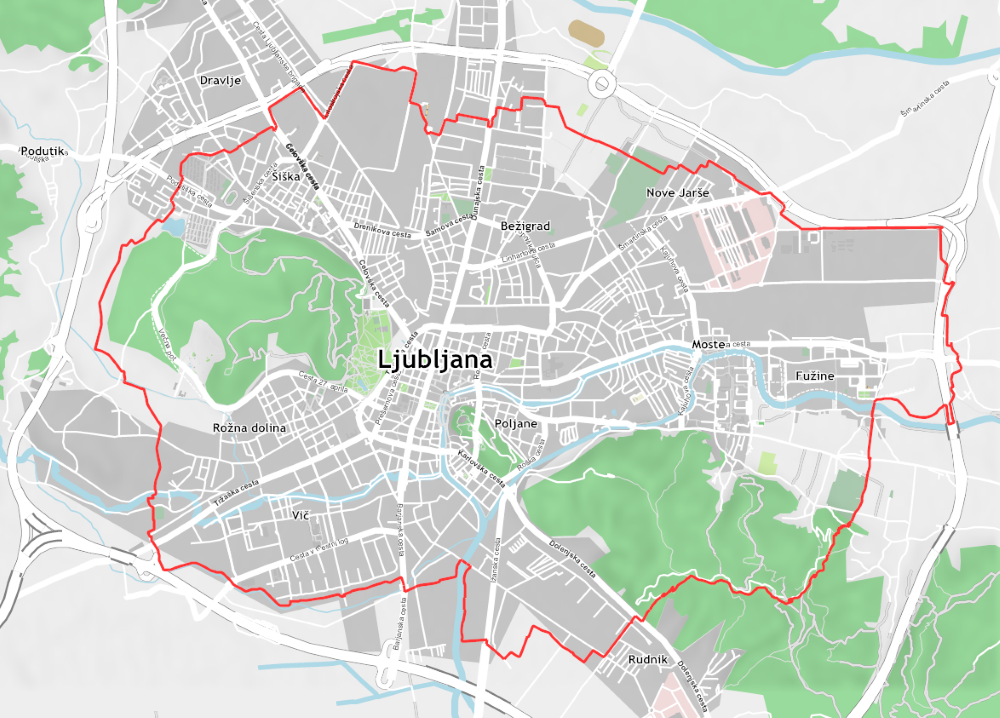
Wednesday evening, for the whole of May, you can take English improv classes with the team behind IGLU Theatre – learn more here.
Thursday, 17:00, there’s a curious event, a workshop open to women only and hosted by the artist Charlotte Jarvis an called Making Female Semen, with an open to all public presentation at 19:00, both held at the Galerija Kapelica / Kapelica Gallery. Details, in English and Slovene, here.
Thursday also sees an opening (18:00) for perhaps the best photographer of Ljubljana, a guy who always finds beauty in unexpected places, Igor Andjelić of the Gallery Minimal. This will be at Kavarna Sosteka (here. Later that evening,
© Igor Andjelić
Elsewhere in town there’s the Mini-Maker Fair, a “conglomerate of scientific, entrepreneurial, educational and craft operations” for children and teens that - the website is Facebook page has all the details, in Slovene and English.
Sunday Tivoli Park sees an all day (10:00 to 18:00) event for families, Čarobni dan, or Magical Day, with workshops, games and music. Best of all? Entrance is free. Details Contents
- Cinemas and films
- Clubbing
- Live music
- Theatre and dance
- Harm reduction and drug testing
- Things to do with children
- LGBT+ Ljubljana
- Ljubljana Castle
- Museums and galleries
- Other things to do in Ljubljana
- Daytrips
- Getting around & miscellaneous
Cinemas and films
You can read about all the cinemas in town here, while a selection of what’s playing this week is below, and note that kids' movies tend to be shown in dubbed versions, while non-English language movies for older viewers will have Slovenian subtitles.Parents should also pay attention to Kinobalon, which is Kinodvor's regular weekend series of film screenings and events for children, from babies on up, with special parent/child events, "first time in a cinema" screenings, and babysitting. Learn more about it here, and see the current schedule here.Kinodvor –This is an arts cinema, not far from the train station, that shows new features as well as hosting the occassional festival.
Kinoteka – And not far from Kinodvor you can find this revival cinema, which shows art house classics along with some deep dives in the archives.
Kino Bežigrad - A relatively small theatre, but one which usually has the biggest of the new releases.
Kolosej -The multiplex out at BTC City Mall shows all the big movies, with well over a dozen titles on the schedule, although note that there are far more movies than screens, so some of the older ones mayonly be playing once or twice a week.
Clubbing
Compared to some European capitals it can seem that nightlife in Ljubljana ends rather early, especially along the river, but there are still bars that stay open late and clubs were you can dance until dawn, and perhaps the best place to stumble across something interesting is the legendary Metelkova. Be aware it's a grungy kind of place and not for all tastes, but also that there's considerable variety to found within the various clubs there, from death metal to electropop, gay cabaret to art noise. You can read "the rules" of the place here. And if you're curious about how the place started then read our story, and look at some pictures, about last year's 25th anniversary.
Božidar - DJ events aren't too common here, but when they happen they often have a big name.
Channel Zero – DJs shows here include regular dub nights as well as electronic music.
Gala Hala – Another Metelkova venue, you can sometimes hear bhangra and Bollywood here, but more often funk, hip hop, breakbeat and so on.
Klub Cirkus – The more commercial end of clubland, and a venue that aims to serve the student party scene. Expect house, anthems, and bangers.
Klub K4 – The home of techno, old and new, along with various other electronic genres,
Orto Bar– 80s and 90s throwback nights can often be found here, along with rock-based DJ sets.
Live music
Balassi Institute – Free Hungarian music, when available, from the Hungarian cultural institute just a short walk downriver from Dragon Bridge.
Cankerjev dom – The main arts venue in the country hosts classical, opera jazz, folk and occassinally pop.
Cvetličarna – Regional pop and rock concerts can be found here.
Channel Zero – This Metelkova venue sees live shows from punk and rock bands, as well as others.
Gala Hala – Another Metelkova venue with indie bands of various styles.
Kino Šiška – One of the top live venues in the city, with a varied programme that include indie, rock, pop, experimental, hip hop, and so on.
Klub Gromka – Live music is often metal, from sludge to stoner, death to thrash, while punk bands also appear, as do others.
Križanke – The venue that hosts the Ljubljana Festival often has classical music, and some rock, in the open air.
Ljubljana Castle – Jazz, funk and pop every Friday night.
Pinelina dnevna soba – LIve music is rare here, but it does happen.
Slovenska filharmonija– Classical music in the centre of town.
SNG Opera and Ballet - As the name suggests, here you'll find the best of opera and ballet in the country.
Španski borci - While dance is more common here, they also have some contemporary and experimental music shows.
Theatre and dance
Cankerjev dom- The main arts venue in the country always has something of interest going on.
Gledališče IGLU - IGLU Theatre – Saturday night this group is usually putting on an English improv show somewhere in town, but it’s generally promoted after this is written, so check the Facebook before putting on your shoes.
Kino Šiška – One of the top live venues in the city also hosts some dance performance, often of the more experimental variety.
Mini Teater Ljubljana –The English schedule of varied performances, for adults and children, for the month is here.
Ljubljana Puppet Theatre - Puppetry has a long and noble tradition in Slovenia, and you can see performances for children and adults (including non-puppet shows) drawing from the Theatre's rich repetoire as well as new productons.
SNG Opera and Ballet - As the name suggests, here you'll find the best of opera and ballet in the country.
Španski borci - The home ofcontemporary dance(and the EnKnapGroup) in Slovenia.
Harm reduction and drug testing
Drogart is an organization that aims to minimise harm on the party scene, and offers drug-testing services and reports on their webpage. It’s in Slovene, but you can Google translate it or work things out yourself, and our story on the group is here.You can find the latest warnings on fake drugs and high strength pills and powders (in Slovene) here. However, be aware that all the usual drugs are illegal in Slovenia.CBD is legal, though, and our retailer of choice can be found on Trubarjeva cesta - read more about Sena Flora here.
Things to do with children
You can find our Top 12 list of things to do with kids in Ljubljana here. If want to read more about the philosophy behind the wonderful House of Experiments look here, while our trip to the Museum of Illusions is documented here, and there’s always riverside walks, pizza and ice cream. With regard to the latter, take a look at our guide to six places that serve good ice cream in winter, and thus are serious about the dessert.
Mini Teater Ljubljana – The season sees a lot of puppet performances for children, in Slovene, at this theatre not far from Križanke. The English schedule for the month is here.
Ljubljana Puppet Theatre - The puppet theatre near the Central Market and next to the Castle funicular has a full programme or shows, for children and adults, with the schedule here.
LGBT+ Ljubljana
If you want to learn more about Ljubljana Pride, then take a look at our interview with its president here. If you're looking for more general links on "gay Slovenia", including a history of the scene and various projects, then you can find that here, while our stories about the community can be found here.
Klub Monokel – Thislesbian barin Metelkova is open every Friday, although sometimes there are other events
Klub Tiffany –And the gay bar next door is also open on Fridays, while every Monday until June 2019 there'stangoat 18:00. Other things coulds also be planned, so click on the name to find out.
Pritličje – This seems to be the only "always open" LGBT-friendly cafe / bar / events space in town, and perhaps the country, so it's a good thing it's such a good one, open from morning to night, and with fliers and posters letting you know what's happening outside the narrow confines of, say, a general interest online what's on... guide.
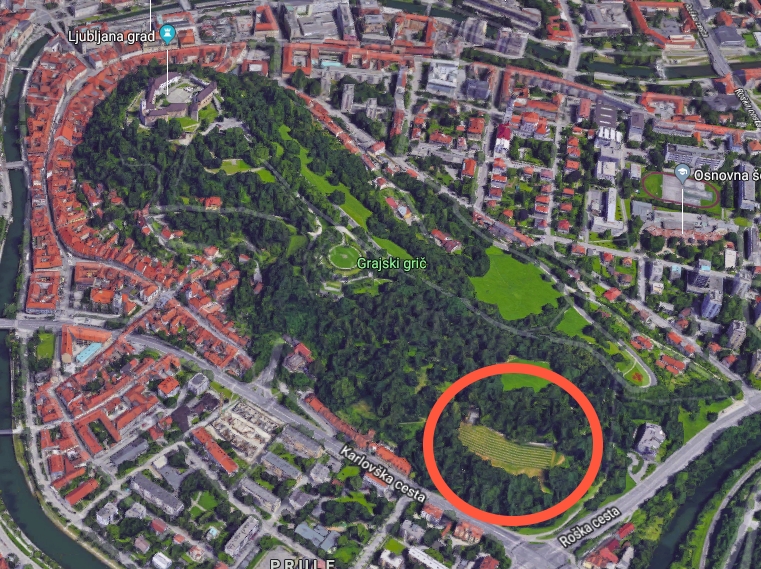
Screenshot from Google Maps, showing the location of the Castle vineyard
Ljubljana Castle
The city’s main attraction is said to be the top tourist draw in the country overall, and to my mind it earns a spot near the top just for the history and views. But beyond that the current owners, the City of Ljubljana, have laid out a varied, interesting and enjoyable programme of events, one that rewards regular revisits.
I try and get up there every Saturday morning to clear my head and move my feet on the trails, and never tire of that end of the hill. At the other end, where the Castle sits, there’s a lot more than fresh air on offer. There are guided tours, restaurants, a café, Castle museum, puppet museum, a Watchtower you can climb to the highest point in the city, art shows, dances, live music, movies under the stars, festival days and more – enough to reward multiple trips up the hill through the year. All of these activities and events can be found on the Castle website, while on TSN you can see “25 things to know about Ljubljana Castle” here, and “Ten Ways to Enjoy Ljubljana Castle” here.
Museums and galleries
Most public galleries and museums are closed on Mondays, although not the National Museum, and - as noted at the start
Cankerjev dom –The 13th Slovenian Biennial of Illustration is here until May 19th, while a free to see show called Subterranean Worlds, showing cave photography, runs until June 16th.
Plečnik's desk. Photo: JL Flanner
Plečnik’s House is worth a visit if you want to learn more about the architect who gave Ljubljana much of its character, and it's also in a really nice part of town, Trnovo, just a short walk or cycle upriver. Read about our guided tour here.
here.
City Museum – The Museum in French Revolution Square an interesting permanent exhibition on the history of Ljubljana, from prehistoric times to the present day, with many artefacts, models and so on that bring the story alive.You can read about my visit here.
The Faces of Ljubljana in the City Museum. Photo: JL Flanner
International Centre of Graphic Arts – Starting March 22 and running until May 19 is Photographic Images and Matter: Japanese Prints of the 1970s and Japan, Yugoslavia and the Biennial of Graphic Arts: Documents of Collaboration. One of the images promoting the show is shown below.
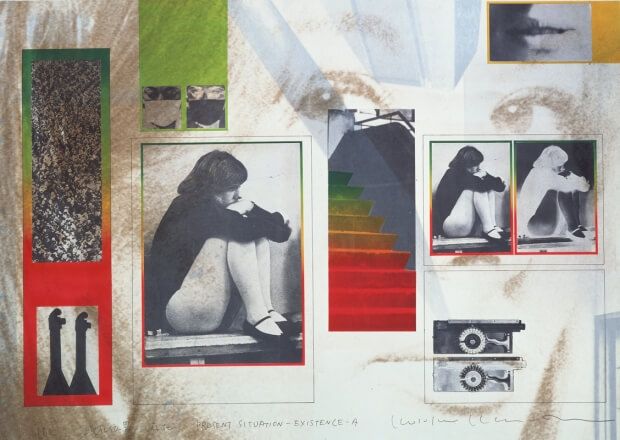
Kosuke Kimura: Present Situation – Existence A, colour and silkscreen, 1971.
MAO – The Museum of Architecture and Design has much of what you'd expect, along with some temporary shows and a good cafe. UntilMay 19 there's Tendencies: Architecture and Urban Planning in Celje, 1955–1985.
Moderna galerija – The main branch of this gallery, to be found near the entrance to Tivoli Park, has a good collection of modern art, as well a nice café in the basement. Opening Thursday, April 25th, 20:00, The Visual Arts in the Kingdom of Yugoslavia, 1929–1941, which then runs until September 15th 2019. This offers “an overview of painting, sculpture, printmaking, drawing, photography, and film from the time the king's dictatorship was set up (6 January 1929) to the beginning of World War II on Yugoslav soil (April 1941)” - you can read more about it here. The museum's Metelkova branch also has a big new show, runing until at least September 2019, an the art of the Non-Aligned Movement, with an example shown below.

Rafikun Nabi: Poet, 1980, print, 96.5 x 110 cm. Courtesy of the Contemporary Art Center of Montenegro. On display at the Metelova branch of the Moderna galerija
National Gallery – The country’s main gallery has “the best” of what’s on offer from the Middle Ages to non-contemporary modern visual arts, and is in a great location for exploring other areas, just by Tivoli Park and opposite the main branch of the Moderna galerija. You can read about our visit to the room containing sacred art from the Middle Ages here.
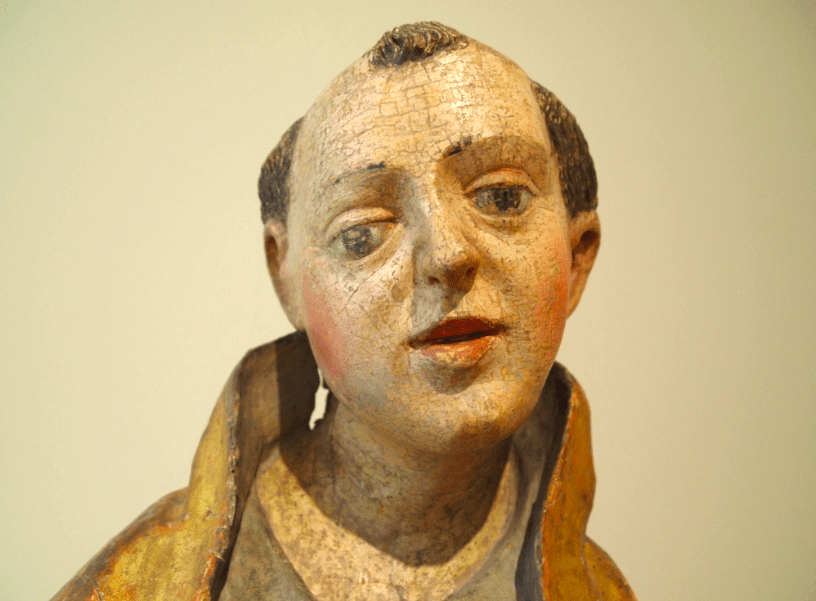
JL Flanner
The real Robba Fountain can be found in the entrance to the National Gallery - the one you see in the Old Town is a genuine fake, as seen below and reported here.

Photo: JL Flanner
National Museum of Slovenia – There’s plenty to see in the permanent collection here, from Roman times, Egypt and more. Meanwhile, the museum's Metelkova branch, located between one branch of the Moderna galerija and the Ethnographic Museum has some rooms on Church art, furniture and weapons, with the latter including more guns than you'll see anywhere else in town, and quite a thrill if coming from a nation where such objects are not household items.
Natural History Museum – On until the end of June 2019 is Our Little Big Sea, which takes a look at the oceans.
National Museum of Contemporary History - Tucked away in park Tivoli, in addition to his permanent collection will be showingIn Search Of Freedom: 1968-2018 until 16 August.
Slovene Ethnographic Museum – The museum currently has a temporary show on Bees and Beekeeping, on until June 16 2019, as well two permanent exhibitions. One of these is called Between Nature and Culture, and has a great collection of objects from Slovenia and around the world, well worth the trip up to the third floor to see it (as recounted here). From April 18 until October 19 (2019) you can also see a show calledShamanism of the Peoples of Siberia, from the Russian Museum of Ethnography, Saint Petersburg. The place is located near the newer branch of the Moderna galerija and Metelkova. You can read about this fascinating show here.
Union is "the Ljubljana beer", but now both it and Laško are owned by Heineken. There are many local brews on offer around town, though, if you want to explore IPAs, stouts, wheatbeers, sours and so on Photo: JL Flanner
Union Experience – The Ljubljana-based brewer has a museum showing the history of the company, with the ticket also including access to part of the factory and a few samples of the product. You can read about our visit here.
Volčji Potok Arboretum - Running until 3 November you can see a large collection of cacti here.
It's not a formal museum, but if you're interested in "Yugo-stalgia" then you'll enjoy a trip to Verba, a small, privately run space that's crammed with objects and pop culture items from the era, and is conveniently located at the start of one of the short walks to the castle. It's also a great place to take pictures, if you leave a donation, and you can read more about it here.
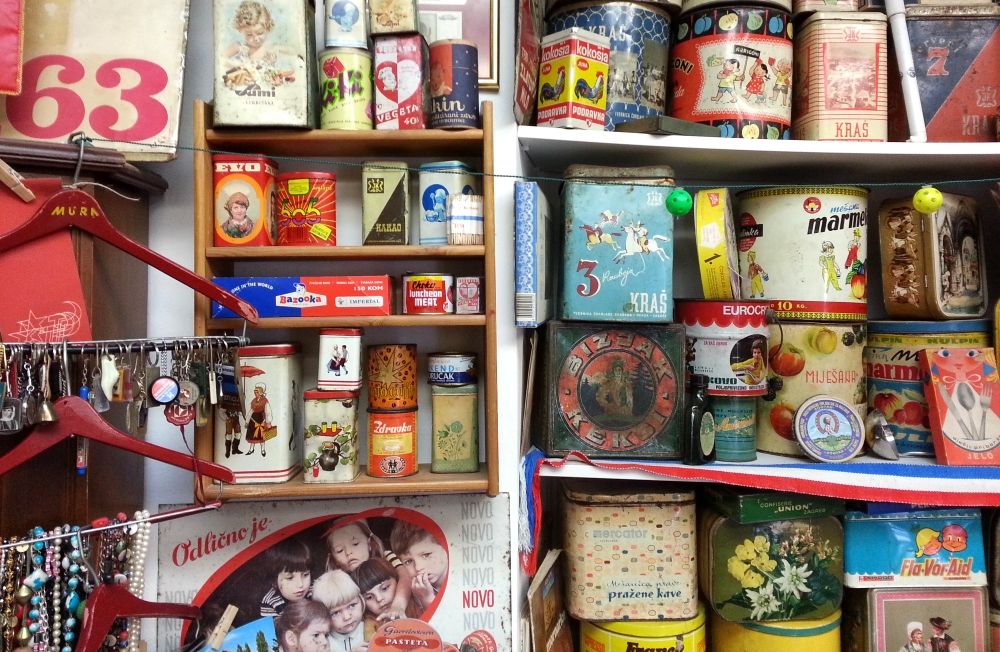
Verba. Photo: JL Flanner
Alternative Ljubljana isn't a museum or gallery, as such, but instead turns the city streets into a museum and gallery. Learn more about their tours of street art, history and LGBT Ljubljana here.

Photo: JL Flanner
Other things to do in Ljubljana
Learn more about Ljubljana with "25 things to know about Slovenia's green city of dragons", or take a look at our guide to spending from four to 48 hours here.
Open Kitchen brings market stalls selling food and drink from some of the best restaurants in town every Friday, from 11am to 11pm, in the square between the cathedral and the river - just follow your nose and the crowds. Read more about it here.
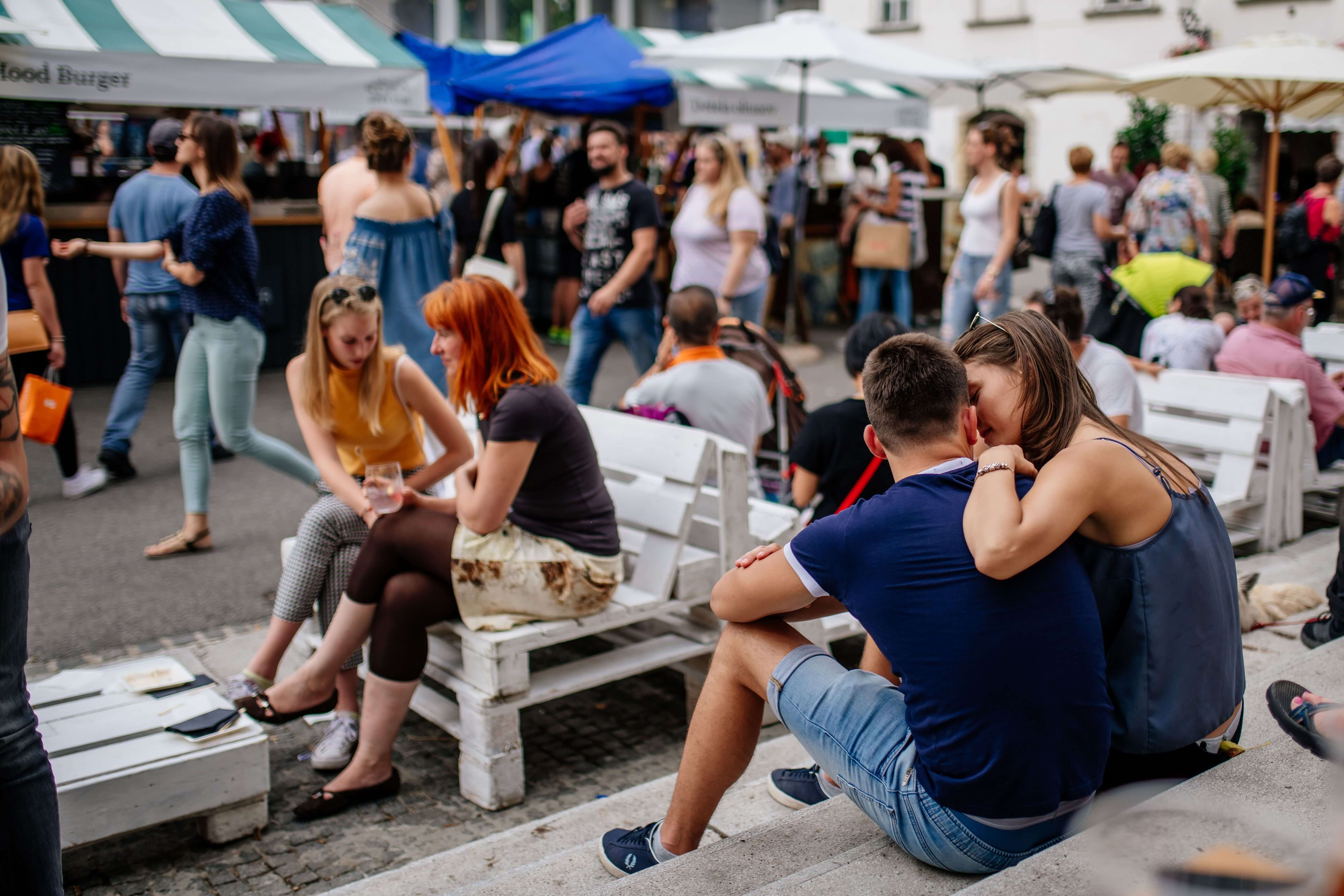
Photo: Open Kitchen
If you'd like to spend an evening painting with others, then take a look at Design with Wine, which organises painting parties on Trubarjeva cesta,
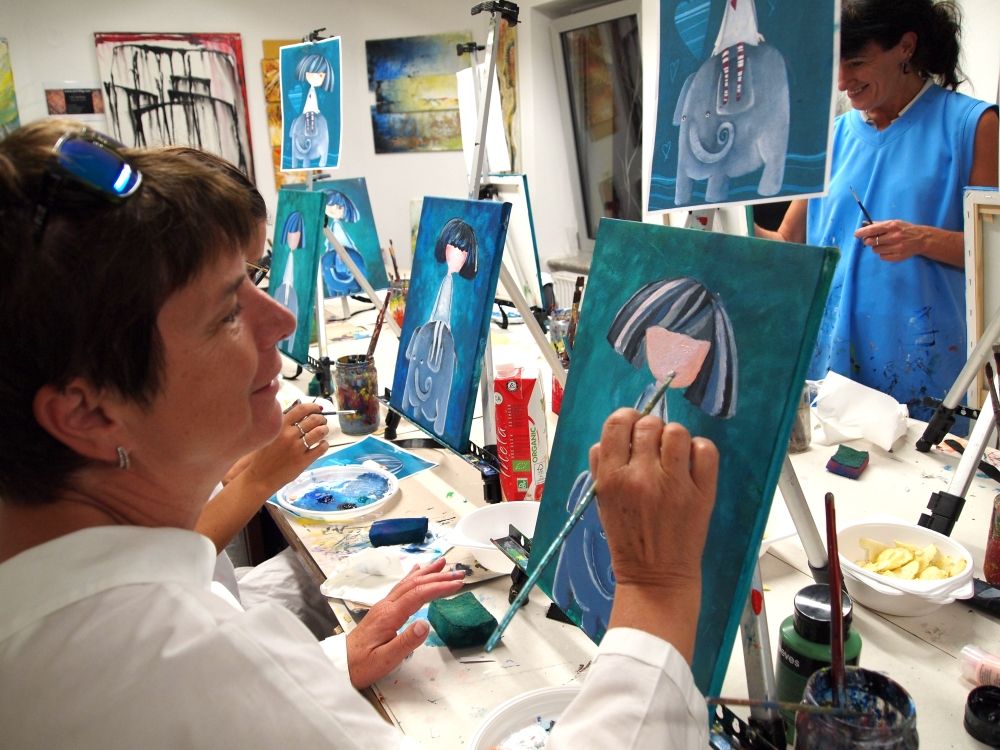
If you want to see some antiques, then check out the wonderful Antika Carniola, as discussed here. The man behind it, Jaka Prijatelj, has a fine eye for life on this street, as you can see on his Facebook account.
Photo: JL Flanner
If you’re in town and want to go jogging or walking in nature, why not take another look at the Castle, with a brief guide to the trails here. If you want something bigger, head to Tivoli Park.
And if you're bored with the Old Town, why not take a walk, cycle or boat ride to nearby Špica and enjoy the riverside life. Learn more about that here.
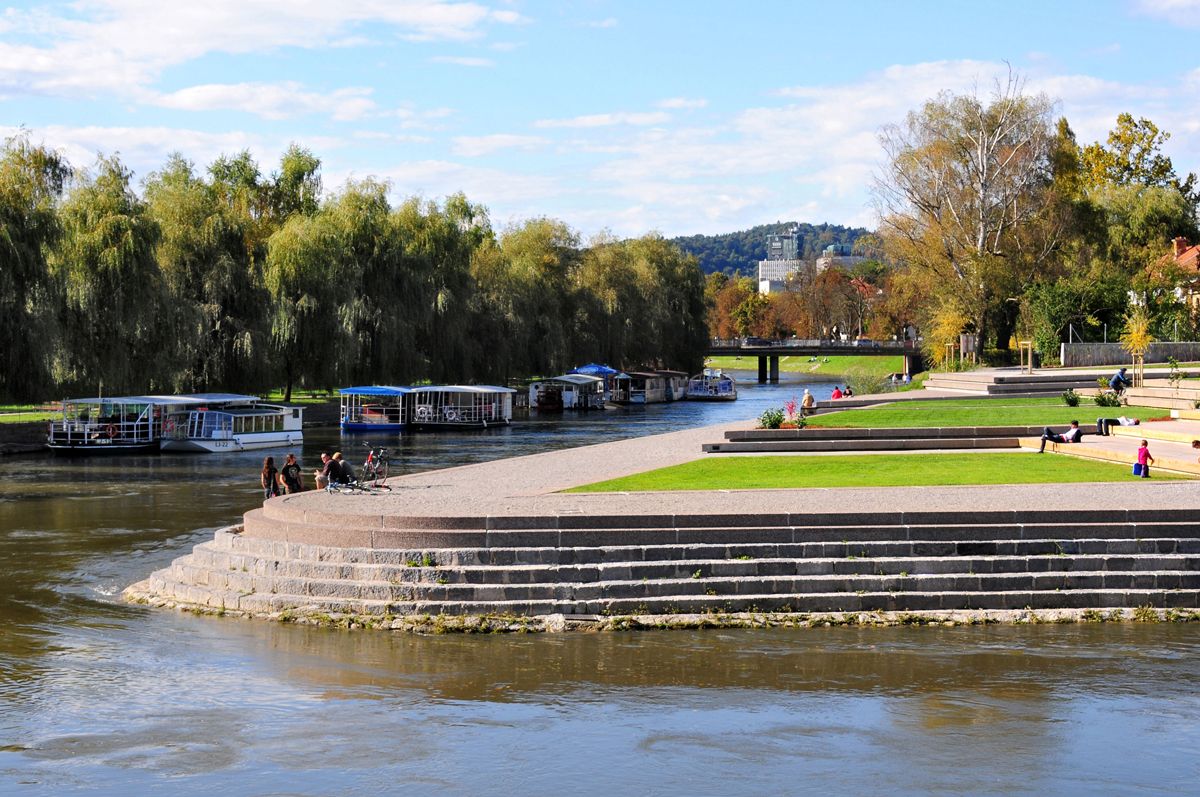
visitljubjana.si
![]()
maxpixel.net, public domain
Want to stretch and breath? Then check out our list of drop-in yoga classes for tourists, visitors and the uncommitted. If you're heading to the coast, check out our interview with a yoga teacher who offers breakfast sessions there, while if you're staying in town (or nearby) and want to try some "family yoga" then you can learn more about that here and maybe get your kids to calm down a moment or two.
Prefer to have someone else stretch you? The check out the totally legit massages you can get from Sense Wellness - either in one of their spas or in you home, office or hotel. (And - to repeat - these are legit and non-sexual in nature)
There are some golf courses near Ljubljana, but even ones further away are not far, as seen in our list of all the golf courses in Slovenia.
![]()
Photo: maxpixel.net, public domain
Daytrips
Most of Slovenia is only a few hours from Ljubljana, and you can easily visit Lake Bled, Lipica Stud Farm, Postojna Cave, Predjama Castle, the coast and other locations, while if you'd like to take a photo of from that bench in Bled, then you can learn how to get there here. If you’re looking for something more ambitious, then check out our recent guide to the 17 members of the Association of Historical Towns of Slovenia. We've also written guides on spending from four to 48 hours in Bled and Piran.
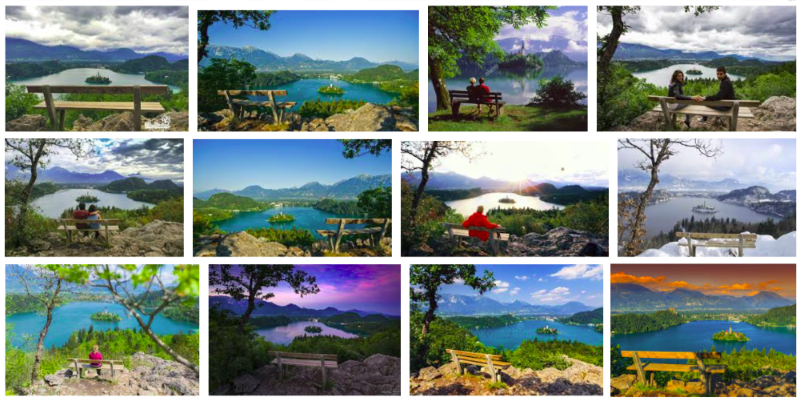
Photo: Google Image Search
Getting around & miscellaneous
If you want to get a Ljubljana Tourist Card, which gives you travel on the city buses and entry to a lot of attractions, then you can read more about that here, and if you want to use the bike share system, as useful for visitors as it is for residents, then you can learn more by clicking this. Visitors with reduced mobility will be pleased to find that downtown Ljubljana is generally rated as good with regard to accessibility, and that there’s a free, city-sponsored app called Ljubljana by Wheelchair highlighting cafés, attractions and so on with ramps, disabled bathrooms and Eurokey facilities, which you can read about and download here. Manual wheelchair users can also borrow, for free, an attachment that will motorise their equipment, as reported here.
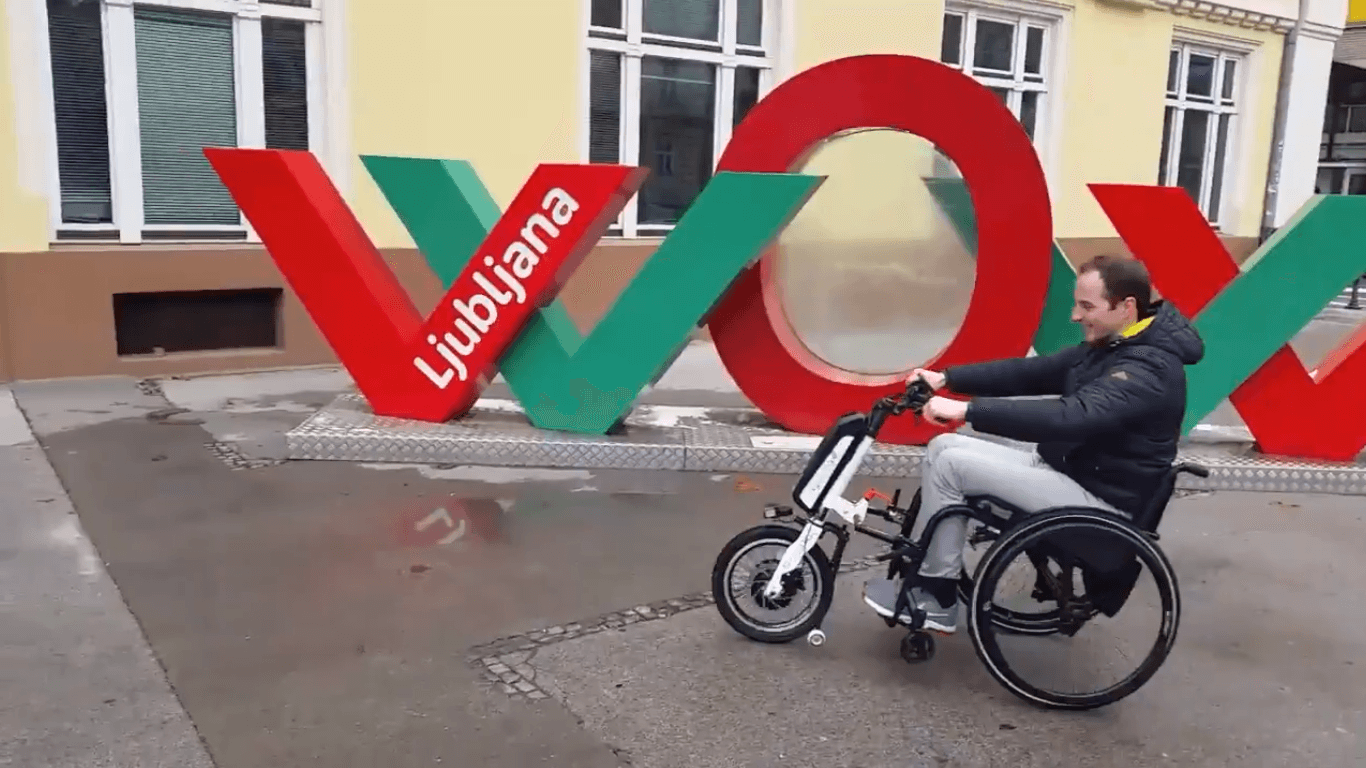
Screenshot from a Twitter video
If you’re driving into town and don’t know where to part, our guide to how to park in Ljubljana is here.
There aren't many places to eat after midnight, and most of them are by the train station, as reported here.
Want / need cigarettes but the stores have closed? Here's an incomplete list of bars downtown that will satisfy your craving for the demon weed. While if you’re having trouble with the ATMs then here’s a guide to the Slovene you’ll see on screen. If you get a hangover then find out where to get paracetamol (and prescription drugs) in Ljubljana here, while details on emergency birth control can be found here.
Ljubljana is a small and relatively safe city, but if need to contact the police then there’s a special number for foreigners, and that’s 113.
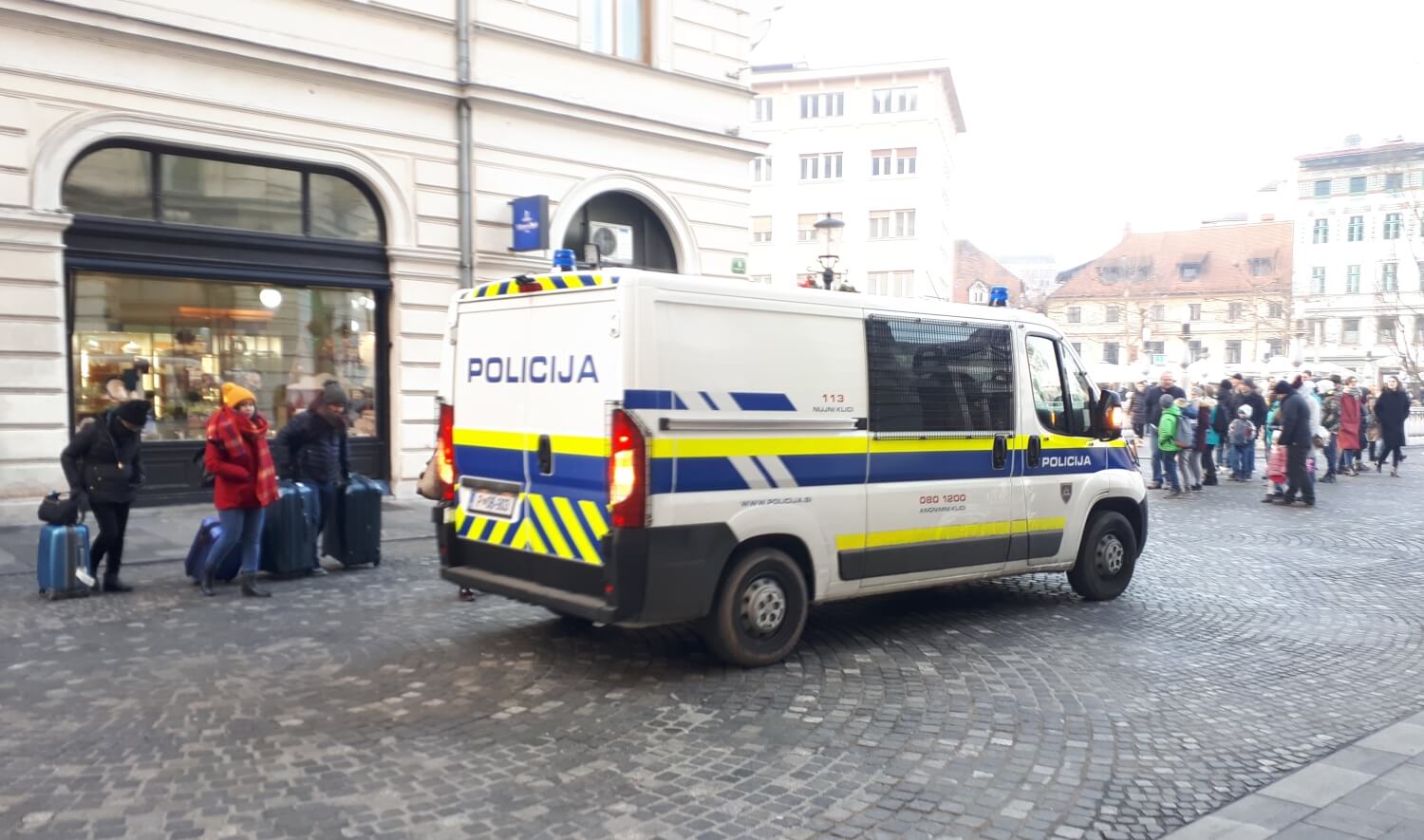
Photo: JL Flanner
Keep up with the daily news in Slovenia by checking the morning headlines here
The following schedule was prepared by the STA:
MONDAY, 6 May
GOING, Austria - Foreign Minister Miro Cerar will pay an informal visit to Tyrol upon an invitation by Austrian counterpart Karin Kneissl; until 7 May.
LJUBLJANA - The deadline expires for filing candidacies for the post to be vacated at the country's top court in September by Constitutional Court judge Etelka Korpič Horvat.
POSTOJNA/CERKLJE OB KRKI/MARIBOR... - The annual regional military exercises that will feature members of armies from 25 allied and partner countries will start in Slovenia; until 22 May.
LJUBLJANA - The STA will host a panel on the key future challenges of vaccination.
LJUBLJANA - Ljubljana will host the congress of the European Society for Paediatric Infectious Diseases: ESPID; until 11 May.
MILAN, Italy - Several Slovenian companies will present themselves at the Tuttofood food industry fair; until 9 May.
LJUBLJANA - The European Parliament Office in Slovenia will organise a panel on books and copyright.
TUESDAY, 7 May
LJUBLJANA - President Borut Pahor will hold a reception to mark the anniversary of the 1989 May Declaration, in which a demand for Slovenia's sovereignty was read out at a mass rally in Ljubljana.
LJUBLJANA - The Employment Service will release registered unemployment figures for April.
LJUBLJANA - A conference dedicated to construction, planning and the environment; until 8 May.
LJUBLJANA - A ceremony will mark the 100th anniversary of Ljubljana's Faculty of Medicine.
LJUBLJANA - The matura secondary school leaving exam will start around the country with an essay in the student's mother tongue, meaning either Slovenian, Italian or Hungarian.
WEDNESDAY, 8 May
TIRANA, Albania - A summit of the Brdo-Brijuni regional initiative that will be hosted by Slovenian President Borut Pahor and his Croatian and Albanian counterparts Kolinda Grabar Kitarović and Ilir Meta; until 9 May.
BRDO PRI KRANJU - A ceremony marking the 15th anniversary of Slovenia's EU accession will be attended by Luxembourg PM Xavier Bettel, Slovenian PM Marjan Šarec, Foreign Minister Miro Cerar and Public Administration Minister Rudi Medved.
LJUBLJANA - The parliamentary Foreign Policy Committee will discuss the initiative for a protocol on changes to the Council of Europe's Personal Data Protection Convention.
LJUBLJANA - The Slovenian-German Chamber of Commerce will present the results of surveys on the economic and investment situation in Central and Eastern Europe.
LJUBLJANA - The STA will host a panel on severe asthma.
VENICE, Italy - The Slovenian pavilion will open at the 58th Venice Biennial; until 24 November.
THURSDAY, 9 May
SIBIU, Romania - Prime Minister Marjan Šarec will attend an informal EU summit.
LJUBLJANA - German President Frank-Walter Steinmeier will start a visit.
LJUBLJANA - The parliamentary Defence Committee will discuss the resolution on the national security strategy.
LJUBLJANA - Telekom Slovenije is expected to release the business report for the first quarter of 2019.
LJUBLJANA - Public broadcaster TV Slovenija will organise a debate of representatives of parliamentary parties ahead of the elections to the European Parliament.
LJUBLJANA - AmCham Slovenija will host the frontrunners of parliamentary parties in the EU election to discuss the EU's challenges in the coming five years.
LJUBLJANA - A series of events called Walk along the Wire that mark Ljubljana's liberation in WWII will get under way.
LJUBLJANA - A concert at the Križanke open air theatre will mark the 50th anniversary of Ljubljana's independent radio station Radio Študent.
FRIDAY, 10 May
LJUBLJANA - The National Electoral Commission (DVK) will announce the official list of candidates for the elections to the European Parliament.
LJUBLJANA - German President Frank-Walter Steinmeier and his host Borut Pahor will discuss the EU's future with the students of Ljubljana's Faculty of Social Sciences.
LJUBLJANA - A parliamentary inquiry commission investigating alleged money laundering at the NKBM bank and alleged illegal financing of the opposition Democrats (SDS) will be in session.
SATURDAY, 11 May
LJUBLJANA - Hikers and runners will take the 35-kilometre path around Ljubljana tracing WWII barbed wire, on the final day of the Walk along the Wire.
LJUBLJANA - EU projects and their results will be presented at more than 100 events around Slovenia as part of the EU Project, My Project campaign; until 18 May.
SUNDAY, 12 May
No major events are scheduled.
Maribor Town Hall was built in 1515, remodeled later in the century, renovated in the mid-19th, and then later returned to its original, 16th century, appearance. Above, and below, are some picture of the place in the 20th century, all public domain and sourced from Wikipedia.
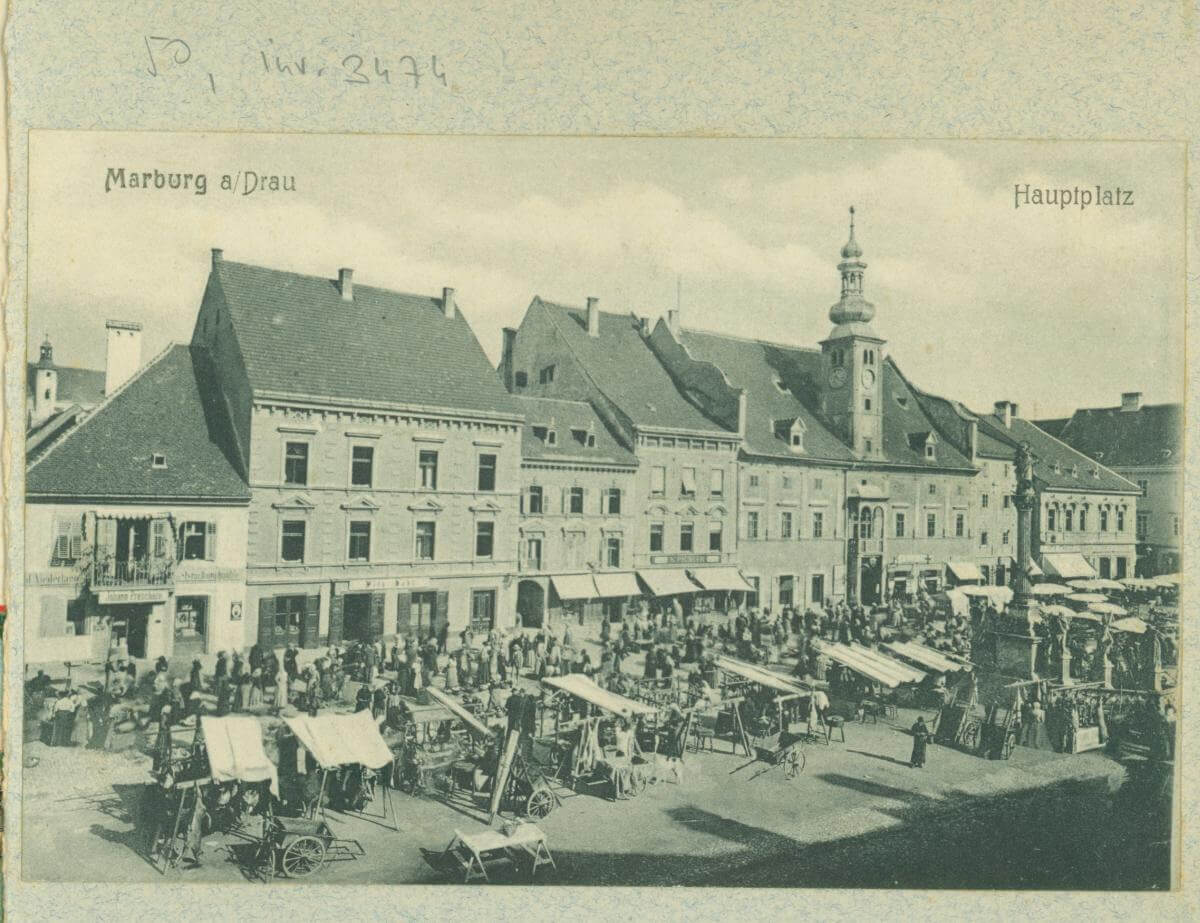
1903

1903
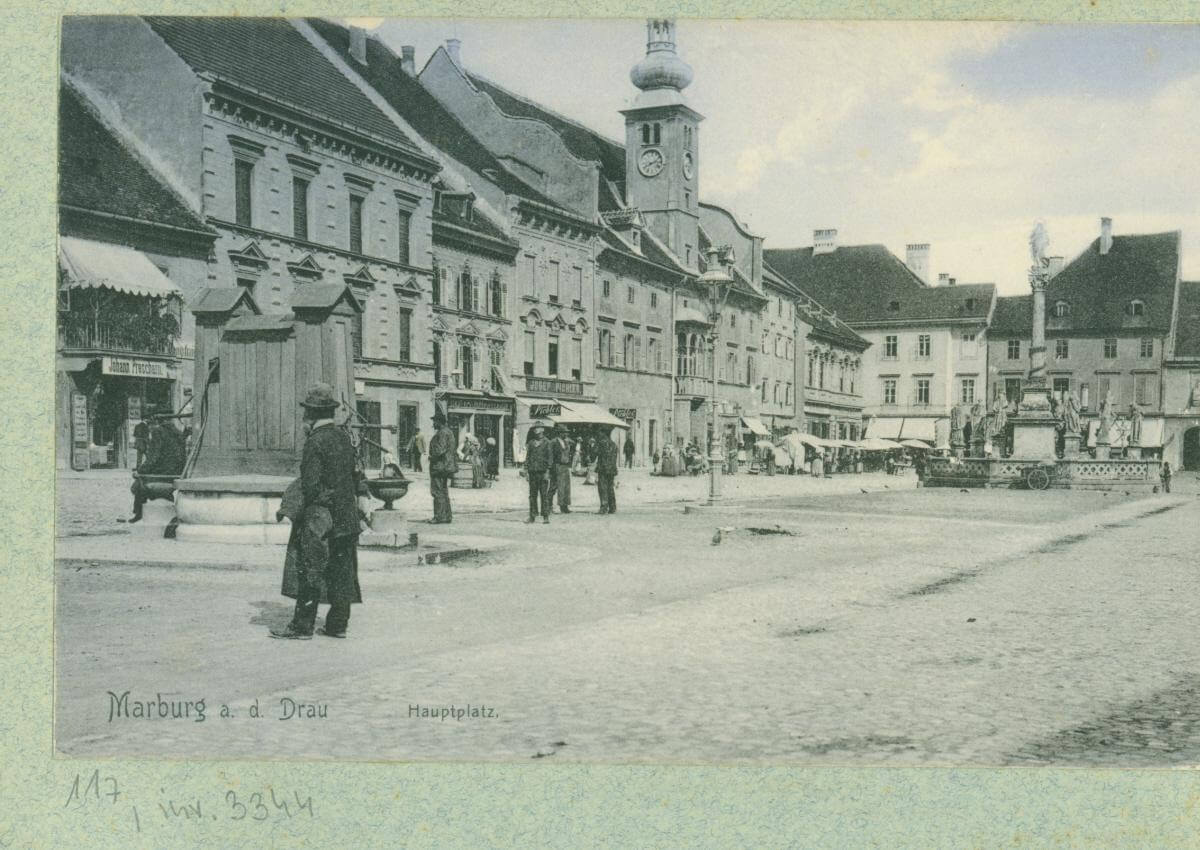
1903

Early 20th century

1916
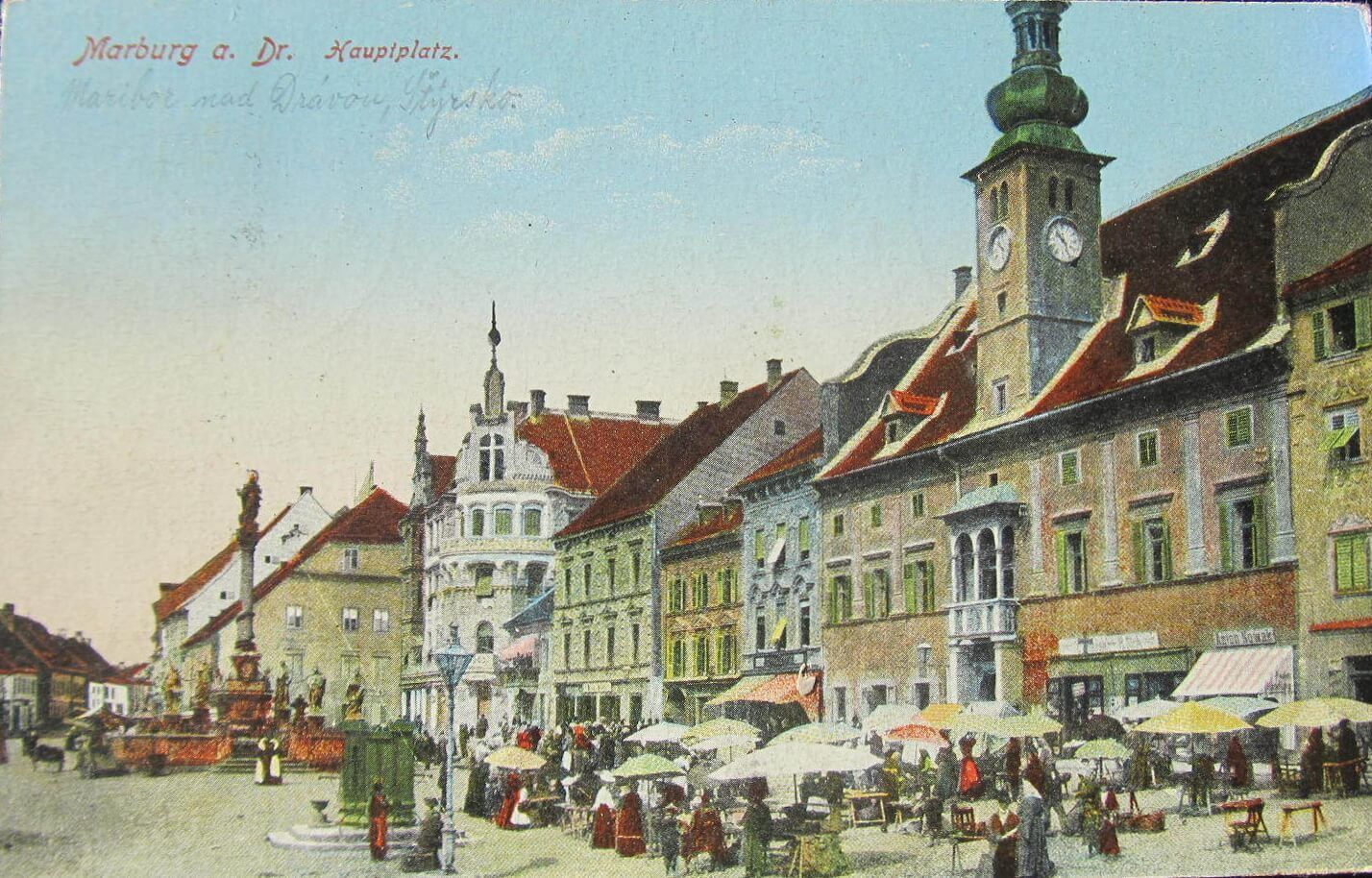
1916
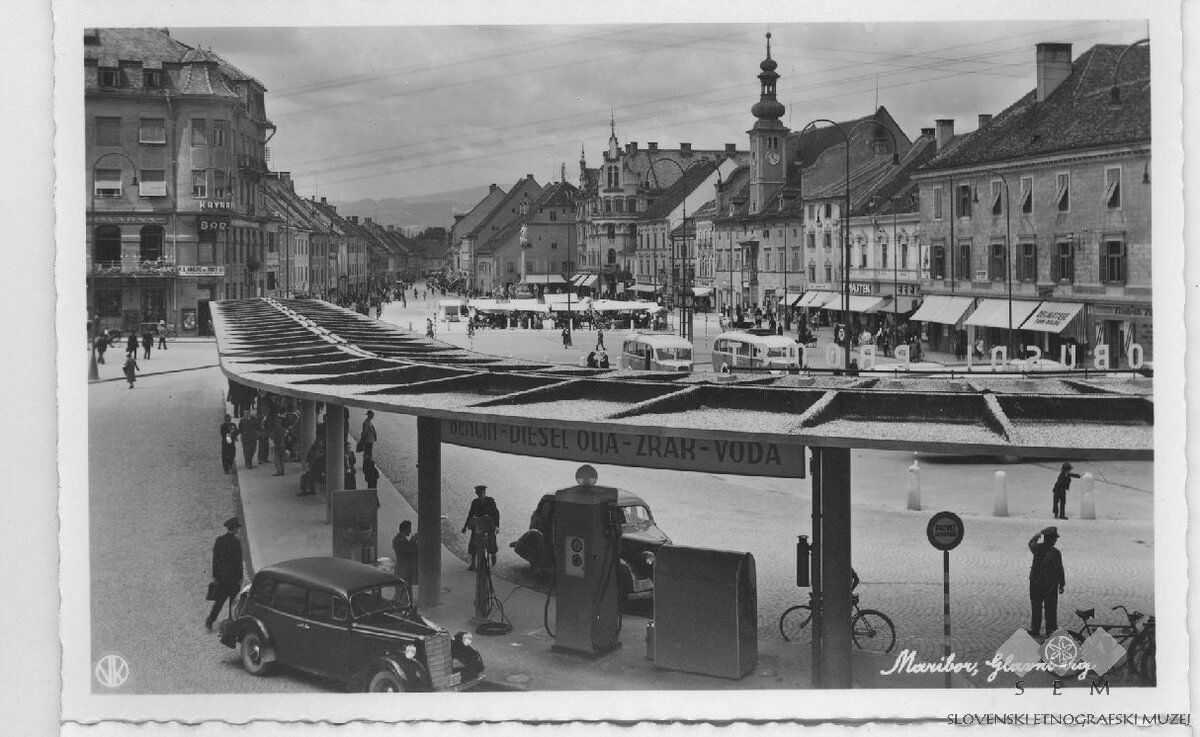
Mid-20th century
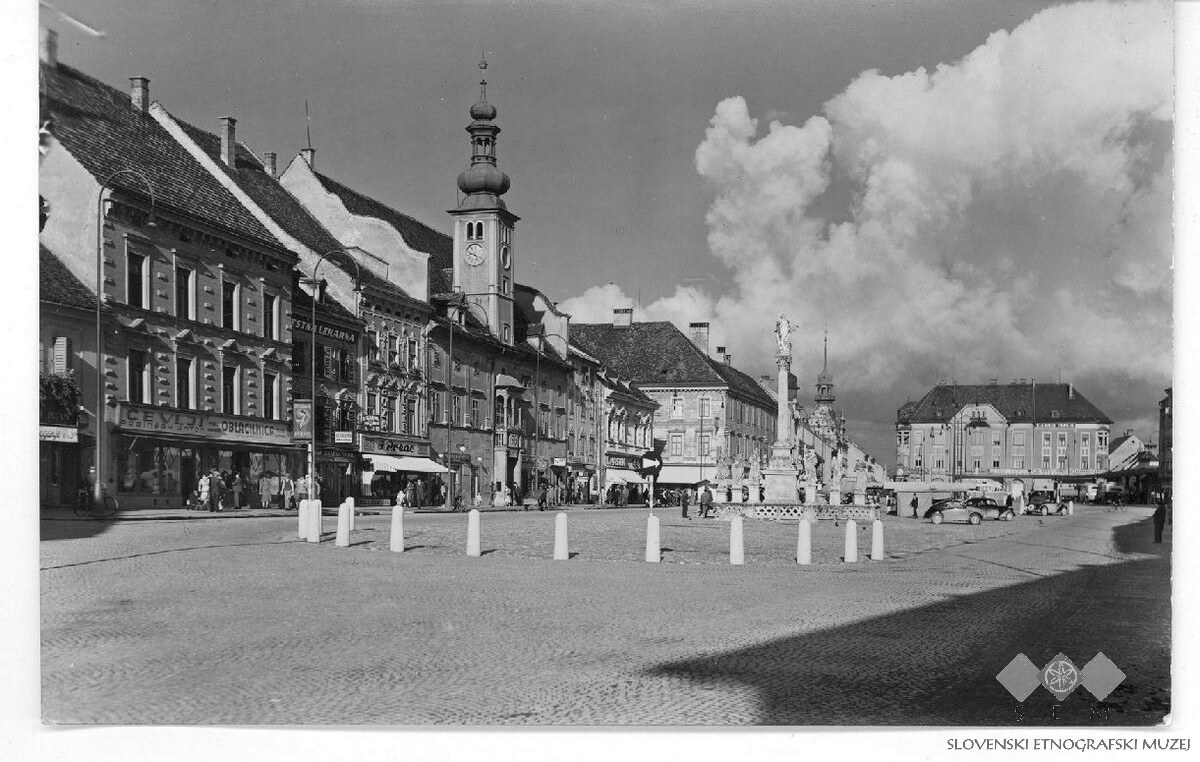
Mid-20th century

1958
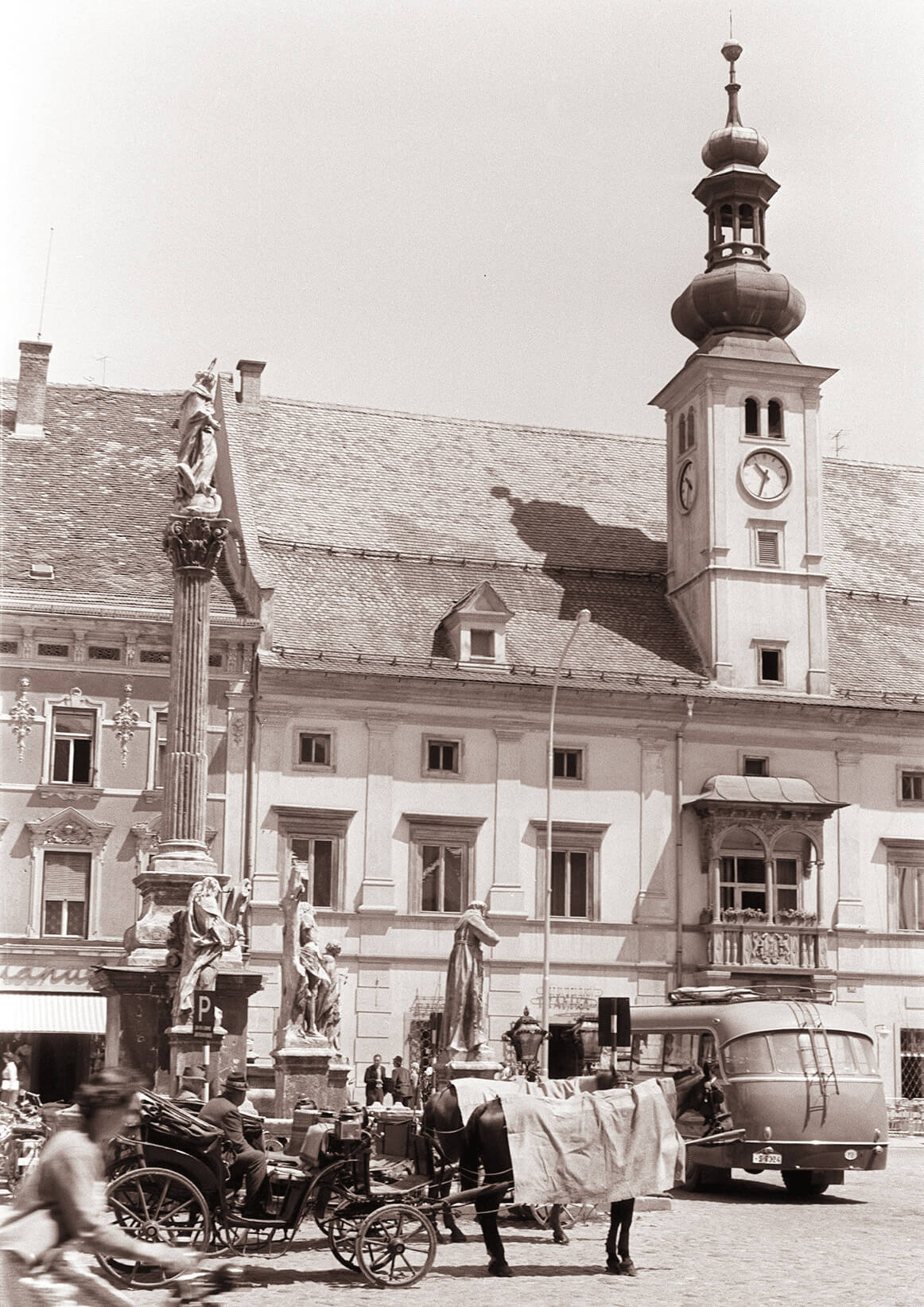
1960

1960

1963

1968
Other posts in this series can be found here
Bookmark this link and find the headlines faster each morning, or follow us on Facebook
A schedule of all the main events involving Slovenia this week can be found here
Visiting Ljubljana? Check out what's on this week, while all our stories on Slovenia, from newest to oldest, are here
This summary is provided by the STA:
Societe Generale to sell SKB Banka to Hungarian OTP
PARIS, France - The French group Societe Generale signed an agreement with OTP Bank Group on selling SKB Banka and its subsidiaries to the Hungarian financial service provider, which will thus enter the Slovenian market. The value of the deal for SKB, which is among the top five largest banks in the country and generated EUR 57.6m in net profit in 2018, has not been disclosed. OTP is reportedly also one of the three most serious bidders for Slovenia's third largest bank Abanka. Societe Generale acquired SKB in 2001, when it was the third largest Slovenian bank.
Slovenian journalists call for freedom and protection of press
LJUBLJANA - Marking World Press Freedom Day, the Slovene Association of Journalists (DNS) urged politicians, media owners and the public to respect and keep protecting the freedom of the press. Journalists are facing an unprecedented amount of pressure nowadays, warned the DNS about the media situation in Slovenia. The Association of Journalists and Publicists (ZNP) urged the authorities to search for measures reducing political pressure on the public media.
Maribor criminal police head replaced after driving drunk
MARIBOR - The head of the Maribor criminal police Robert Munda has been replaced by his deputy Andrej Kolbl nearly three months after he was caught driving drunk. According to the official statement of the Maribor Police, the replacement had nothing to do with the incident. Munda was transferred due to requirements of work organisation, public communications officer Miran Šadl told public broadcaster Radio Slovenija.
Cream of EU cinema awaiting film lovers as part of Europe Film Week
LJUBLJANA - The Europe Film Week will start on 4 May, featuring free screenings of 33 contemporary European films in twelve Slovenian cities and running until 13 June. The screenings will be held all around the country, in Celje, Maribor, Murska Sobota, Nova Gorica, Sežana, Kranj, Novo Mesto, Dolenjske Toplice, Izola, Slovenska Bistrica, Ptuj and Ravne na Koroškem.
Mladina: Police found EU Commission dictated bank bailout in criminal fashion
STA, 3 May 2019 - Lies, Lies, It's All Lies, reads the title of the latest Mladina editorial, which comments on the findings of the National Bureau of Investigation (NBI) probe into the 2013 bank bailout. According to the left-leaning weekly, the European Commission determined the value of Slovenia's allegedly bankrupt banks without any sort of methodology.
Commenting on what appears to be a leaked criminal complaint filed by the NBI last December against the entire former board of Banka Slovenije, Mladina's editor Grega Repovž says a long time has passed since the emergence of a document that would reveal the actual methods of the European Commission so clearly.
Repovž says the report of the NBI probe - over which Slovenia is being sued by the European Commission - into what was happening at the Slovenian central bank before the bailout reads like a conspiracy theory or a script for a bad movie and warrants a European investigation into the Commission's workings.
Repovž says officials in Slovenia were initially resisting pressure from the Commission to wind up recapitalisation needs but eventually caved in and started to focus on covering the tracks, thus becoming complicit in a crime.
The value of the banks was actually determined by the Commission, which ignored all the actual findings and failed to explain its methodology.
Slovenian police were hoping to find the contentious methodology that would explain the final figures but their eventual discovery was the worst possible - there was no methodology.
"We declared three banks, which were actually not in such a bad state, as bankrupt, pumped EUR 4.78bn into them ... and then accepted the commitment to sell these falsely bankrupt banks," Repovž says.
He argues that it seems Slovenia was truly being used as a guinea pig for enforcing the bail-in principle and for preventing a joint shouldering of the burdens of troubled countries.
However, while NKBM and NLB, stuffed with excess capital from the bailout, were privatised in line with promises given to the Commission, Prime Minister Marjan Šarec cannot continue pretending old commitments need to be honoured and ignore the findings of the probe as Slovenia is in the process of also selling Abanka.
Note – The STA didn’t provide a summary of Demokracja’s editorial this week, but the following is from last week’s Reporter, another right-wing weekly.
Reporter: Unlikely Homeland League will take away SDS votes
STA, 23 April 2019 - Commenting on the ongoing EU election race, the weekly Reporter says in its latest editorial that the newly-established party Homeland League (DOM) is not likely to eat away votes to the opposition Democrats (SDS).
According to the latest poll by Mediana, the Slovenian right will be defeated on the election Sunday, 26 May, as the lists of the SDS and the non-parliamentary People's Party (SLS) as well as the opposition New Slovenia (NSi) are projected to win only three MEP seats, editor-in-chief Silvester Šurla says.
The joint SDS-SLS slate is expected to win the most votes, but only two of Slovenia's eight MEP seats. It could also win a third one by a hair's breadth, just like the SDS did five years ago.
Perhaps it will also manage to win three seats this year because of the alliance with the SLS. However, according to the latest polls, winning four MEPs is not likely, Šurla notes.
The NSi is also not likely to repeat its historic victory from 2004, when the first European election was held in Slovenia and the party won as many as two MEPs.
In the end, the left and right may very well each win four seats, just like ten years ago, Šurla says under the headline Race for Million Euro.
The centre-left has slightly more voters although they are inclined to change party preferences. Most of them currently favour the coalition Social Democrats (SD), which are projected to win two MEPs, while the senior coalition Marjan Šarec List (LMŠ) and the opposition Left would each get one.
Meanwhile, voters of the centre-right, are much more decided. This is why Šurla expects no major flow of SDS voters to the Homeland League, which does not even appear in opinion polls yet.
Perhaps, DOM could cost the SDS-SLS list of candidates only the third potential MEP seat, Šurla concludes.
All our posts in this series can be found here, and our stories on the Institute of Chemistry are here
STA, 3 May 2019 - The Europe Film Week will start on 4 May, featuring free screenings of 33 contemporary European films in twelve Slovenian cities and running until 13 June.
The screenings will be held all around the country, in Celje, Maribor, Murska Sobota, Nova Gorica, Sežana, Kranj, Novo Mesto, Dolenjske Toplice, Izola, Slovenska Bistrica, Ptuj and Ravne na Koroškem.
Altogether, 23 EU-funded films will be shown at 33 screenings, including the Icelandic-Ukrainian film Woman at War, which has received the Lux prize award of the European Parliament for 2018.
The film, directed by Benedikt Erlingsson, was also the winner of the 29th Ljubljana International Film Festival (Liffe). It presents the story of a determined woman who strives to protect the Icelandic highlands by disrupting the operations of a local aluminium plant.
Woman at War will be shown in Celje, Murska Sobota, Kranj, Sežana, Novo Mesto, Izola and Ptuj.
Nova Gorica and Sežana will hold screenings of the German-French film Transit by Christian Petzold, set in Nazi-occupied France, while film enthusiasts will be able to see the co-production film Cold War by Polish director Pawel Pawlikowski in Novo Mesto and Ptuj.
Erik Poppe's Utoya: July 22, a movie about the 2011 Utoya massacre, will be shown in Izola and Slovenska Bistrica.
The Europe Film Week takes place every year in May, celebrating Europe Day by presenting diverse and quality European films to a wider audience.
The full programme can be seen here
This week saw the 500th anniversary of Leonardo da Vinci’s death, with both scholarly and popular interest in the man and his work showing no sign of abating half a millennium after his passing. Among the many articles marking this occasion was one published by RTV Slovenia, in conjunction with a documentary shown by the national broadcaster, which added some local interest to the story of one of the original Renaissance men.
Da Vinci thus devised a plan that would prevent Turkish invasions of the Venetian Republic by using a system of dams and allowing the flooding of certain valleys, as well as designing a movable artillery defensive system in the Posočje region, and sketching a picture of the bridge over the Vipava River.
However, while the Atlantic Codex reveals that da Vinci undoubtedly visited and studied the confluence of the Vipava and Soča rivers, present-day Gorica, and surrounding areas, his plans for the building of a Venetian defensive line remained, like so many of his ideas and inventions, unrealised.
If you want more confidence and spontaneity then why not take a few classes in improvisation and learn how to create opportunities, live in the moment, and play well with others. Thinking on your feet, and in a group, is a skill that translates to far more contexts than a theatre or comedy club, although that’s where you’ll often see the people behind the upcoming IGLU Improv Classes in English.
Held several times a year, the next run of classes begins next week, and will be taught be Sara Šoukal. The first session will take place on Wednesday, 8 May (2019), running from17:30 to 19:30, and will continue at the same time and place each week until the end of the month, with the place being Celovška cesta 150, Ljubljana.
The cost of one class is €20, with a discount price of €60 if you sign up for all four. If you’re interested then please send a message to This email address is being protected from spambots. You need JavaScript enabled to view it. at least two days before the first class, at which point you’ll receive more details.
The related Facebook page is here, while you can keep up with IGLU’s frequent improv performances, often in English, here.
STA, 2 May 2019 - The international urban initiative Jane's Walk, which promotes walking and responsible city planning, will again also be embraced by several Slovenian cities this year.
Special guided tours, lasting roughly an hour and half and offering people a chance to explore hidden corners of cities, are scheduled throughout May and have been confirmed for 18 cities around the country so far.
Ljubljana's Upper Šiška borough will for instance already be explored this Sunday, while two more tours will be organised in the capital.
Related: Let's See the City - Ljubljana architectural walks and tours
Interesting small towns such as Tolmin, Litija, Črnomelj or Dravograd are also joining the initiative, which is coordinated in Slovenia by the Institute for Spatial Policies (Inštitut za politike prostora –IPoP), an urban planning NGO. A detailed list of the walks can be found on IPoP's website.
Named after Canadian activist Jane Jacobs, Jane's Walks are a global movement launched in 2007 and organised in Slovenia since 2011.
Related: Meet the People - Hayley Handford-Brown, Bringing the Streets Alive with Hand Drawn Adventure Maps
The free, citizen-led walking tours get people to tell stories about their communities, explore their cities, and connect with neighbours. They are also meant to stimulate reflection on existing and potential planning solutions.
The international website for Jane’s Walks, in English, is here
Get the headlines every morning here, while the events scheduled for the next week can be found here
A review of major events in the week between 26 April and 2 May, as prepared by the STA:
FRIDAY, 26 April
LJUBLJANA - The parliamentary commission in charge of overseeing intelligence and security services accused Defence Minister Karl Erjavec of abusing the military intelligence service to dismiss Brigadier Miha Škerbinc as the force commander of the Slovenian Armed Forces. Erjavec, who denies the charge, appointed Brigadier Milan Žurman Škerbinc's successor effective on 30 April.
LJUBLJANA - Foreign Minister Miro Cerar and his visiting Norwegian counterpart Ine Marie Eriksen Soreide noted the good relationship between the two countries. Norway and Slovenia "are in many ways two similar-minded countries", Cerar said.
LJUBLJANA/BRUSSELS, Belgium - Perceived independence of judges remains a sore spot for Slovenia's judiciary, according to the 2019 EU Justice Scoreboard. The country placed 22nd, based on 2017 data, a two-spot improvement over the year before. The country has considerably reduced court backlogs.
LJUBLJANA - A poll released by POP TV on the first day of the election campaign gave the joint list of the opposition Democrats (SDS) and the non-parliamentary People's Party (SLS) 12.3% of the vote, followed by the coalition SocDems with 12.2%. PM Marjan Šarec's LMŠ polled at 10.1% and the opposition National Party (SNS) at 7.2%.
BRUSSELS, Belgium - Some 75% of Slovenians who took part in the most recent Eurobarometer survey feel that being a member of the EU has benefited their country. Some 37% feel the EU is no longer on the right track, while 38% feel that way about Slovenia.
LJUBLJANA - Retail group Mercator posted EUR 1.6m in net profit for last year, an improvement over its EUR 184m loss in the year before. Sales revenue was up by 1.2% year-on-year, reaching EUR 2.18bn. Revenue from retail, the group's core business, increased by 3.2% to EUR 1.63bn.
KRANJ - The recently sold Gorenjska Banka doubled its pre-tax profit to EUR 20.68m in 2018. Net profit nearly tripled compared to the year before, amounting to EUR 17.1m, showed the annual report.
MARIBOR - The newspaper publisher Večer offloaded its entire magazine portfolio to focus on general interest media as it prepares to merge with rival newspaper publisher Dnevnik. The magazines have been sold to three companies that are part of a sprawling media empire controlled by Martin Odlazek, seen by many as one of the most influential people in Slovenia.
SATURDAY, 27 April
JELŠANE - Some 400 locals living along the border near the Jelšane crossing staged a rally demanding better border protection and rejecting the idea of their community hosting a processing centre for migrants.
LJUBLJANA - President Borut Pahor described Resistance Day as a "glorious day" that celebrates rebellion against attempts to destroy the Slovenian nation. Rebellious people risked their lives and resisted are patriots who deserve respect and admiration notwithstanding what accompanied the national liberation struggle, he said.
LJUBLJANA - Ratings agency Moody's upgraded Slovenia's outlook to stable from positive as it kept its country rating at Baa1. The outlook was changed due to the government effective response to issues exposed by the debt crisis, the Finance Ministry said.
LJUBLJANA - A total of 103 candidates running on 14 lists will vie for eight seats allotted to Slovenia in the European Parliament, showed the final tally by the National Electoral Commission. There will be 51 women on the ballot and 52 men and six lists, including by five parliamentary parties, have made women their top candidates.
SUNDAY, 28 April
LJUBLJANA - The government's approval rating improved by 3.6 p.p. in Aril compared to March to stand at 56%, showed a poll commissioned by POP TV. Support for the senior coalition Marjan Šarec List (LMŠ) grew as well, to 17% from 16.5%. The LMŠ is followed by the opposition Democrats (SDS), which lost more than one point to 14.3%, showed the poll by Mediana.
BRUSSELS, Belgium - Slovenia is seen as a stable, constructive and pro-European country which however does not fully use the potential to play the role a small country can play in the EU, Slovenia's former European Commissioner Janez Potočnik told the STA ahead of the 15th anniversary of Slovenia's EU accession.
LJUBLJANA - Data from the National Institute of Public Health (NIJZ) showed 47 people died in Slovenia in 2017 of causes related to drug abuse, seven more than in 2016. Drug-related deaths have been rising since 2013.
MONDAY, 29 April
BERLIN, Germany - PM Marjan Šarec stressed as one of the participants the informal summit on the Western Balkans that the much needed agreement between Kosovo and Serbia would have to be in line with international law, well coordinated and comprehensive. Šarec highlighted Slovenia's support to the region on its Euroatlantic path.
LJUBLJANA - The recently privatised NLB announced it will issue EUR 45m in subordinated notes with a ten-year maturity on 6 May. The bonds will have a fixed coupon rate of 4.2% in the first five years.
KRANJ - The AGM of Gorenjska Banka, which is in 98.27% ownership of Serbian AIK Banka, squeezed out small shareholders. It will pay EUR 298 a share to owners of a total of 6,166 shares, the price per share offered in the recent takeover.
LJUBLJANA - It was confirmed that the Competition Protection Agency's (AVK) approved on 25 April the sale of Slovenia-based sports equipment maker Elan to the Finnish-owned KJK fund.
CELJE - Cetis, one of the top printing companies in Europe specialising in secure documents, posted a group net profit of EUR 2.4m, down 67.6% over the year before. The group's revenue dropped by 2.2% to EUR 59.7m.
SAMOBOR, Croatia - Representatives of the largest trade union confederations of Slovenia and Croatia had their annual Labour Day get-together to adopt a joint statement which calls for prudent reflection and a broad social consensus when it comes to plans to increase the retirement age. The statement is titled 67 is Too Much.
TUESDAY, 30 April
LJUBLJANA - The Ljubljana Local Court drastically reduced the fine originally issued to the opposition Democrats (SDS) in connection to the first of its two violations of the political parties act, while only issuing a reprimand as opposed to a fine in connection to the second. The court maintains the SDS broke rules on party funding with two illegal loans taken out in 2017.
LJUBLJANA - Slovenia's annual inflation rate in April was at 1.7%, up 0.1 percentage points compared to March, while 0.8% inflation was recorded on the monthly level. Annual inflation was mostly driven by higher prices of energy, and monthly inflation by dearer holidays and footwear, the Statistics Office said.
LJUBLJANA - The Swedish news portal Nordic Monitor claimed it had obtained secret documents revealing that diplomats working at the Turkish Embassy in Ljubljana spied on a number of critics of Turkey's government and President Recep Tayyip Erdogan. The Foreign Ministry said it was not familiar with the report and did not want to comment.
LJUBLJANA - Tourism and media group DZS posted EUR 2.5m in net profit last year, an improvement over the EUR 91,000 in profit generated the year before. Sales revenue was at EUR 87m, slightly higher than in 2017.
WEDNESDAY, 1 May
RAVNE NA KOROŠKEM - Addressing a Labour Day ceremony in Ravne na Koroškem, Prime Minister Marjan Šarec said that Labour Day was not an ideological holiday but a "holiday of good people, who like to spend time together, who work hard every day and who love their country."
LJUBLJANA - President Borut Pahor urged Slovenians to cast their votes in the upcoming European elections in an interview with the STA ahead the 15th anniversary of Slovenia's joining the EU, observed on 1 May. "All of us, who see the EU as brining a future of peace, security, prosperity and the future for our children have the obligation to do something ... It is our responsibility to encourage people to vote," he said.
WARSAW, Poland - Foreign Minister Miro Cerar attended a ceremony in Warsaw marking the 15th anniversary of the accession of ten countries to the EU. He said that "the EU is strong because it is united by its diversity and differences, big and small".
THURSDAY, 2 May
LJUBLJANA - Both Slovenian journalist associations, the DNS and ZNP, took the opportunity of World Press Freedom Day, 3 May, to urge a comprehensive overhaul of media legislation. The DNS highlighted the increasing concentration of power in the hands of ever fewer media players who care strictly about business as opposed to quality journalism.


